Abstract
Glaucoma has traditionally been thought to affect peripheral visual function in its early stages and to spare central visual function until late in the disease process. The basis for this assumption has been the reliance on Goldmann-type perimetry, a rather sensitive method for assessing the peripheral visual function, and on Snellen-type visual acuity measurements, a rather insensitive method of assessing central visual function. This belief has persisted despite frequent complaints from patients with glaucoma that their central vision is disturbed. Over the past two decades, several investigations of central visual functions and their anatomic substrate have challenged this assumption. Histologic studies of the nerve fiber layer in eyes with glaucoma suggest that the number of ganglion cells subserving macular function is decreased even in early stages of the disease. In addition, afferent pupillary defects (a gross measurement of macular nerve fiber function) may also be present in eyes with early glaucoma. Several studies have demonstrated that color perception (largely mediated by the fovea) is defective in glaucoma. Furthermore, defects in color perception may even precede the development of visual field abnormalities. Seventy-eight percent of patients with early glaucomatous visual field defects were found to have a defect in color perception when tested with a desaturated D-15 color panel that tests only the central 1.5 degrees. In addition, both chromatic and achromatic foveal perception channels are defective in eyes with glaucoma and even in some eyes of those with suspected glaucoma. Contrast sensitivity has become recognized as an important component of visual function. Partial loss of contrast sensitivity may cause a degradation in the quality of perception even though the Snellen visual acuity remains normal. Although contrast sensitivity is not entirely a macular function, it has been shown that as little as 3 degrees of disturbance of the macula (eg, with macular degeneration or with an artificial central scotoma) will reduce the contrast sensitivity, suggesting that this modality is indeed mediated to a significant extent by this portion of the retina. Spatial contrast sensitivity appears to be reduced in patients with glaucoma. However, because of overlap and lack of a sharp cutoff measurement, present testing procedures fail to allow a clear distinction between the glaucomatous and normal populations. Although reduced temporal contrast sensitivity has been demonstrated in glaucomatous eyes by others, I undertook a systematic investigation of this function in a large group of patients with glaucoma and with suspected glaucoma.(ABSTRACT TRUNCATED AT 400 WORDS)
Full text
PDF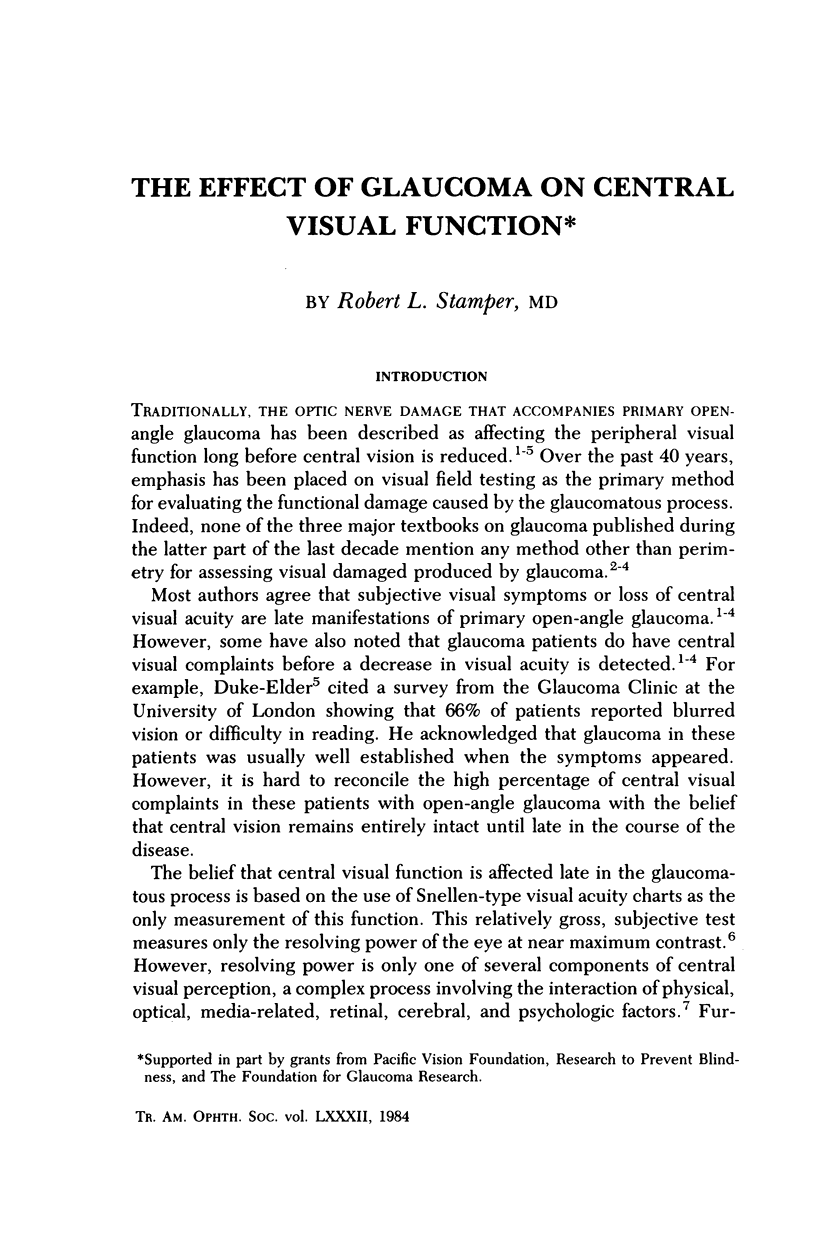
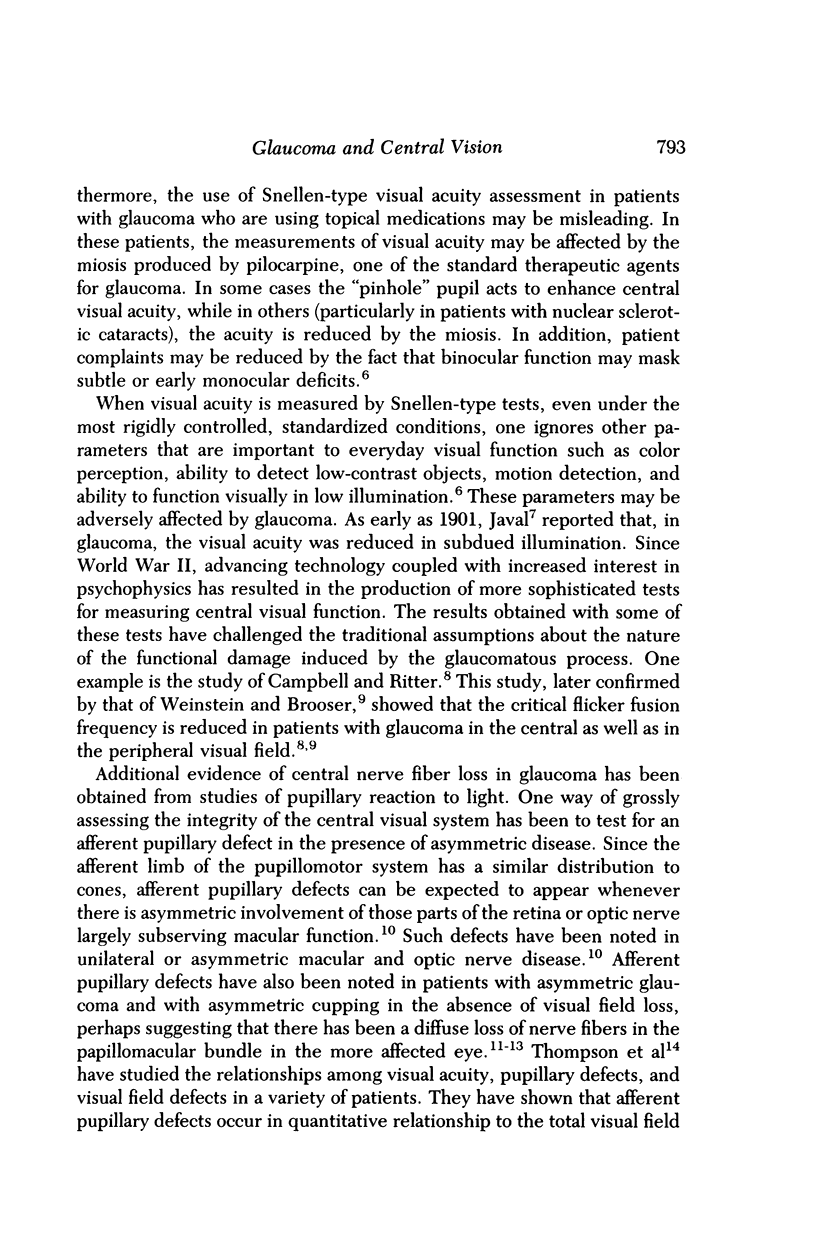
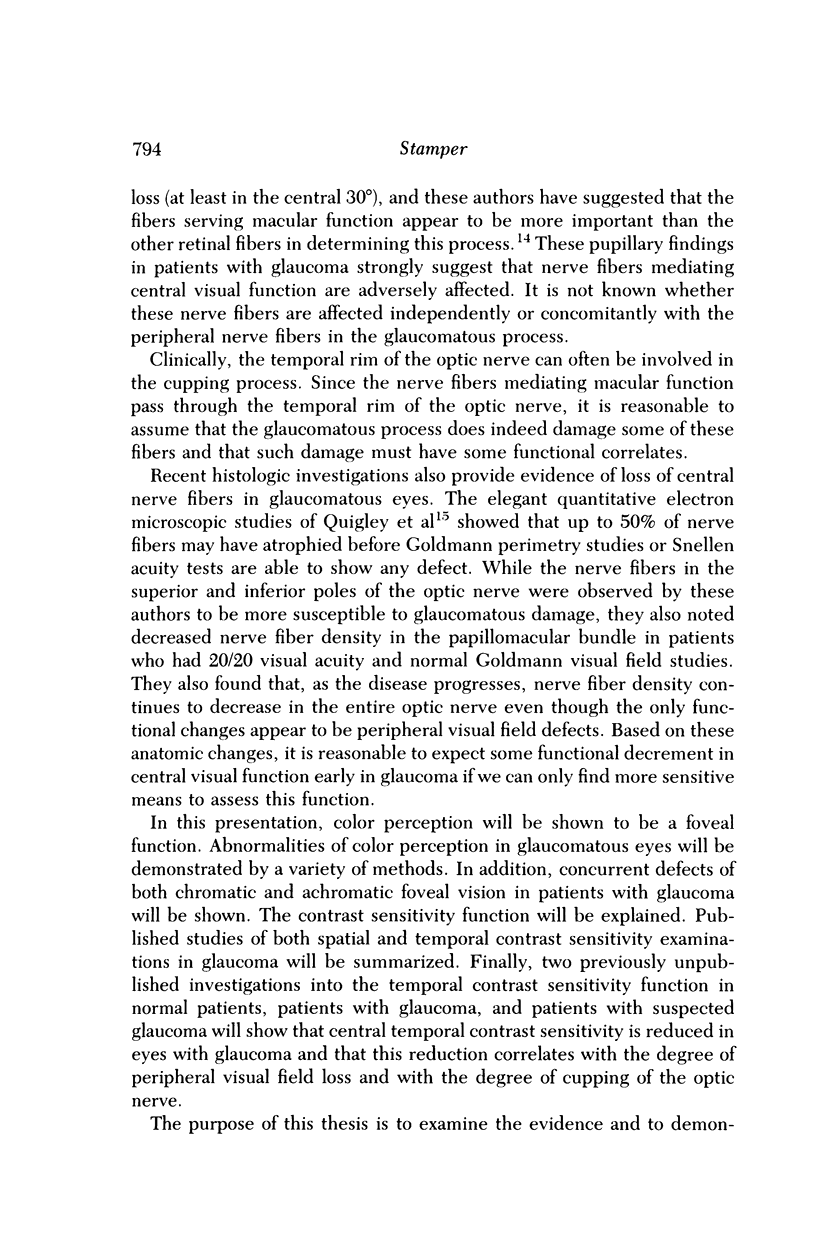
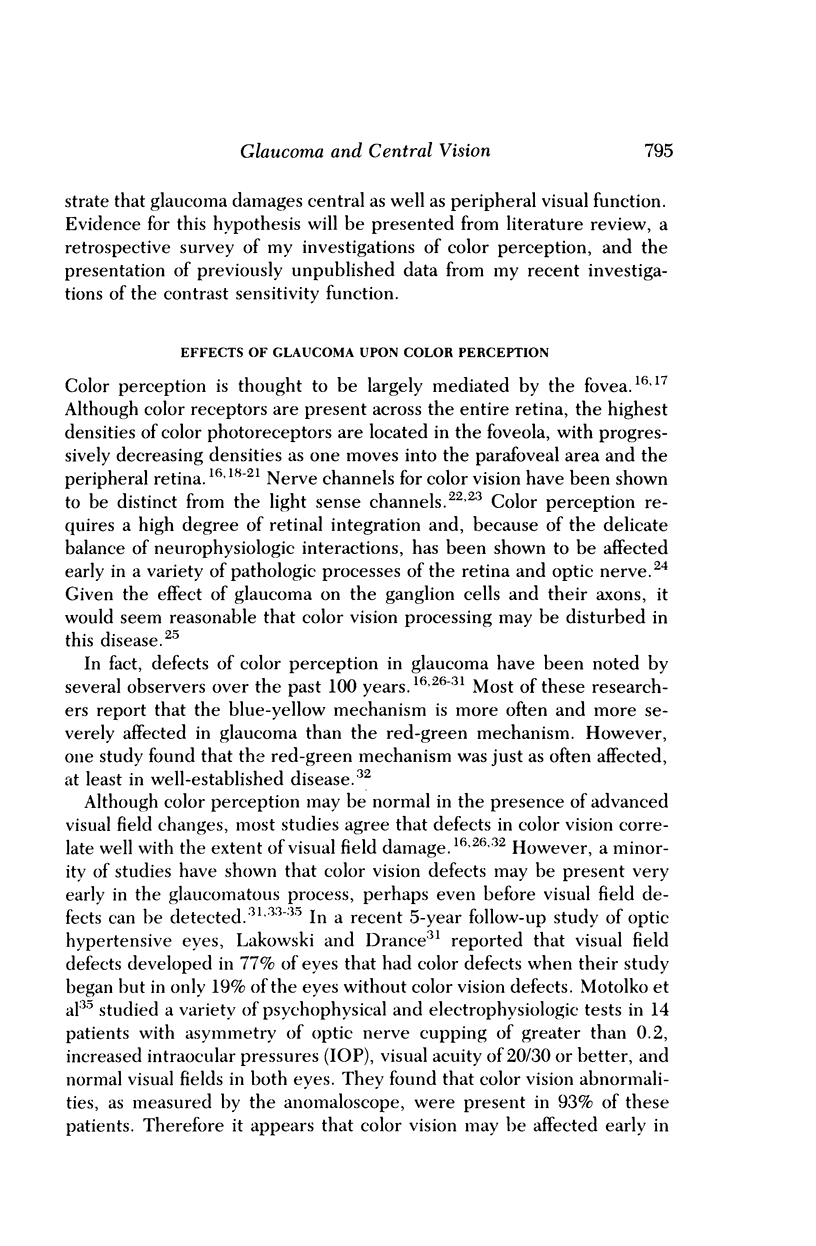
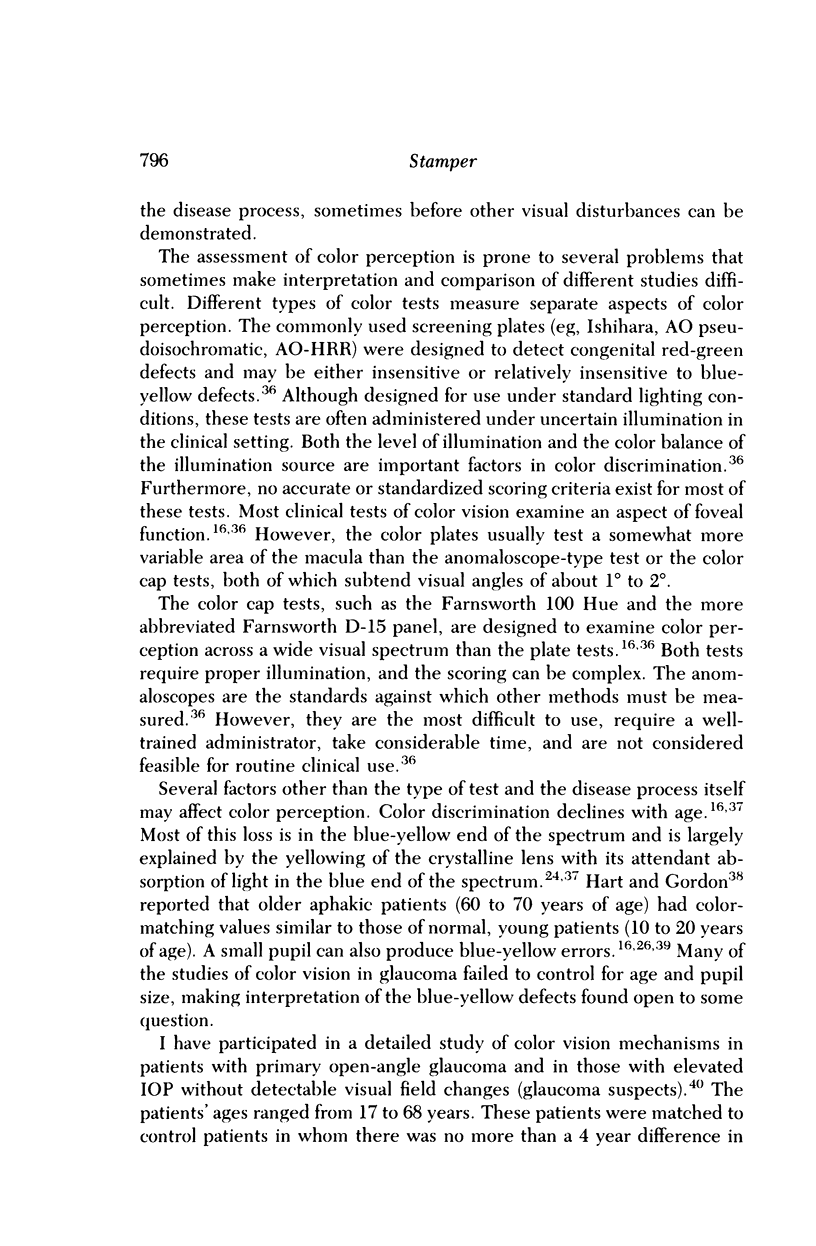
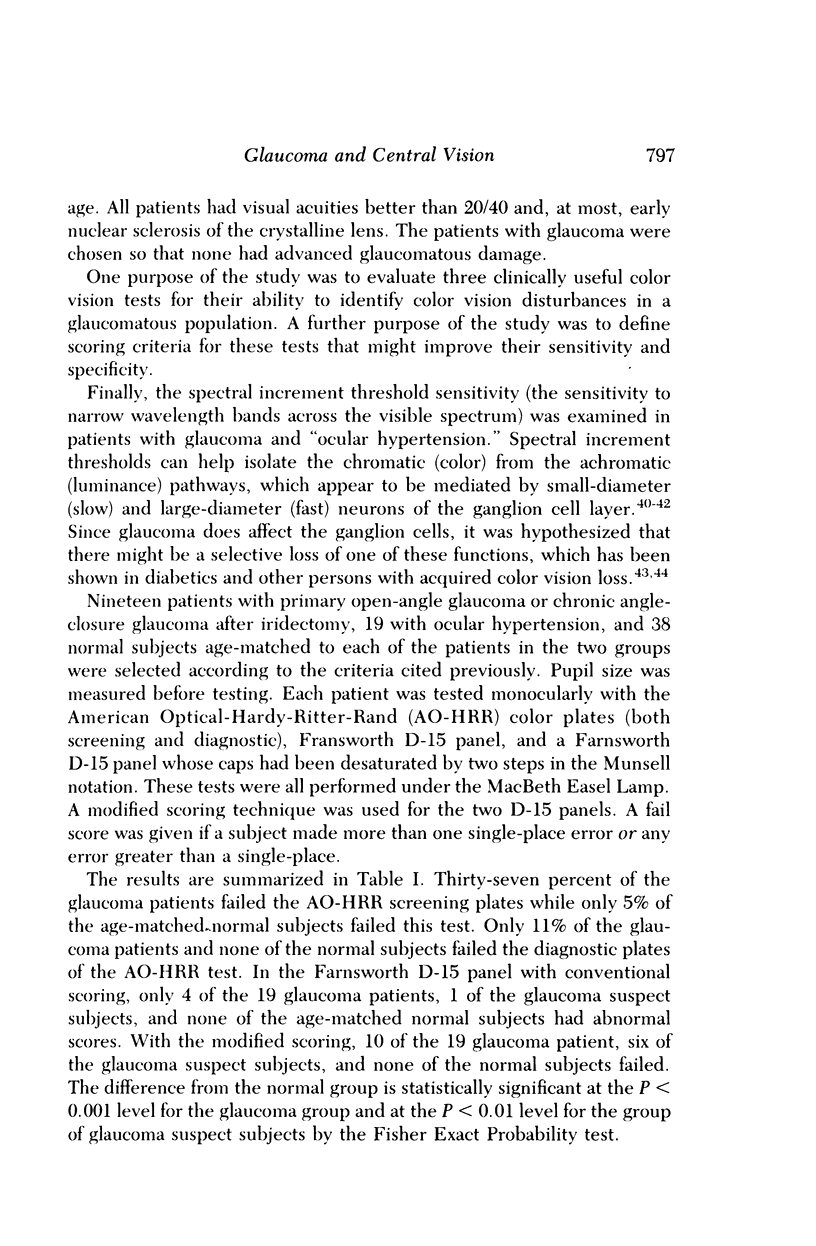
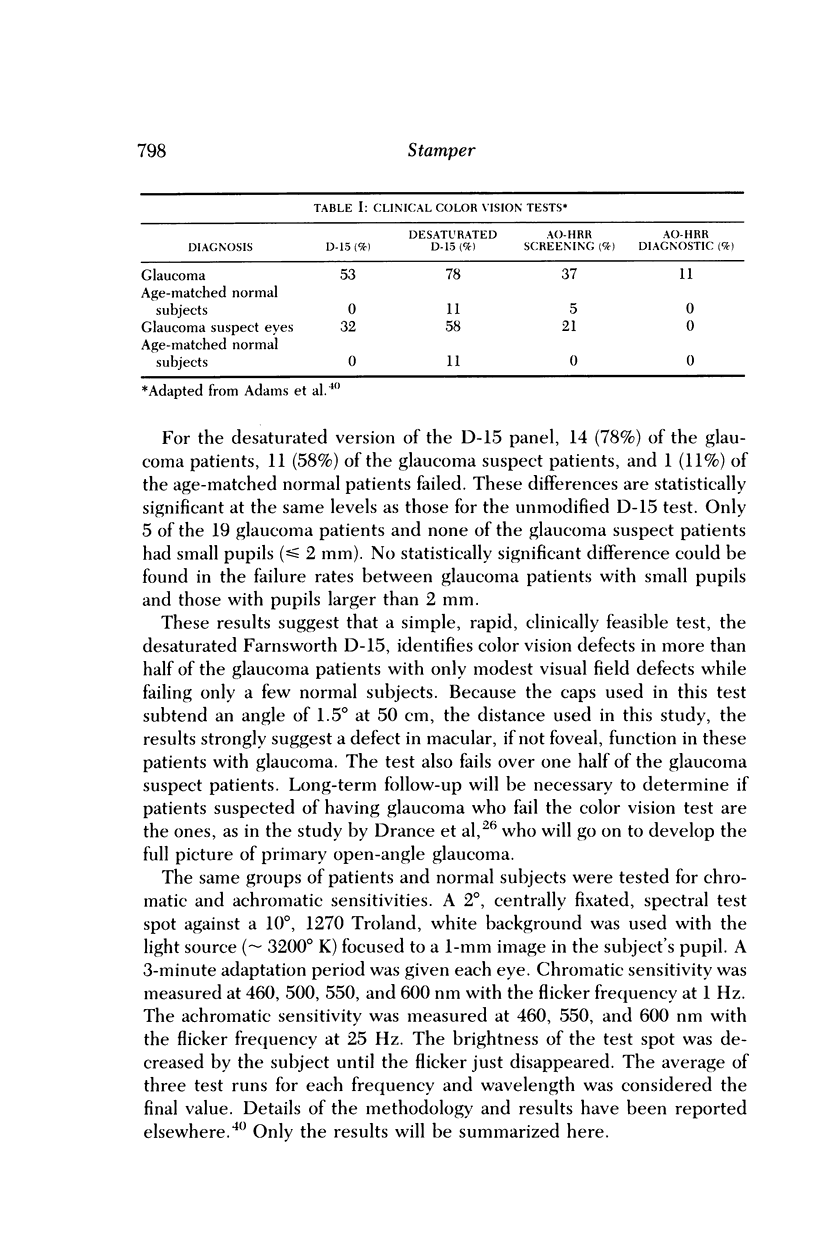
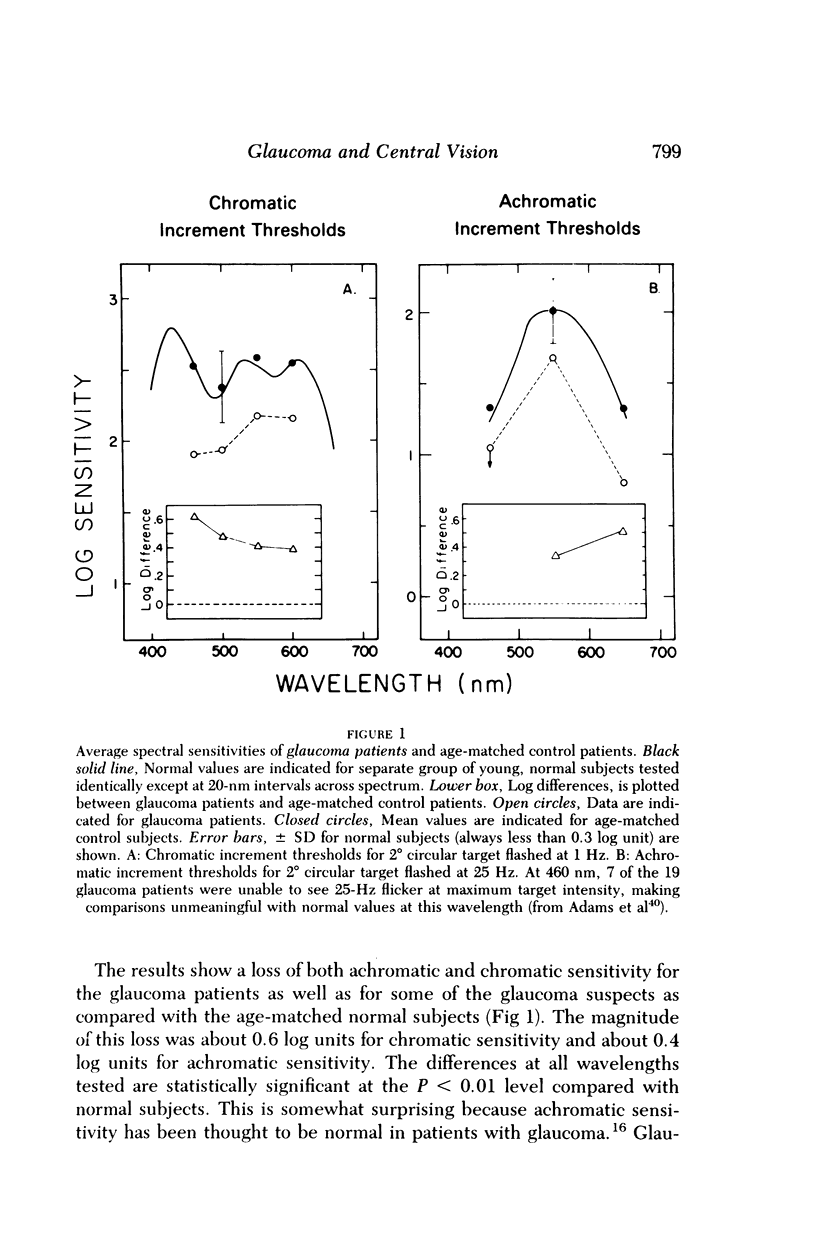
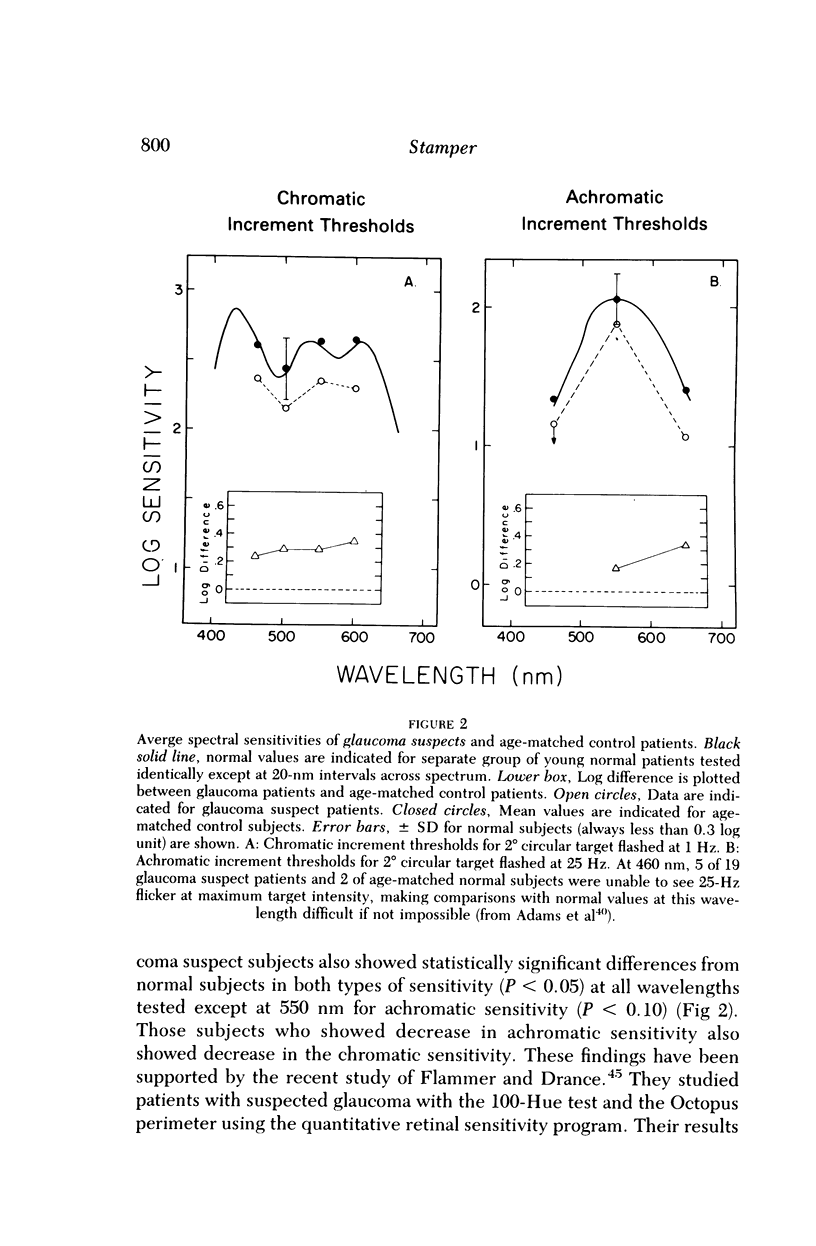
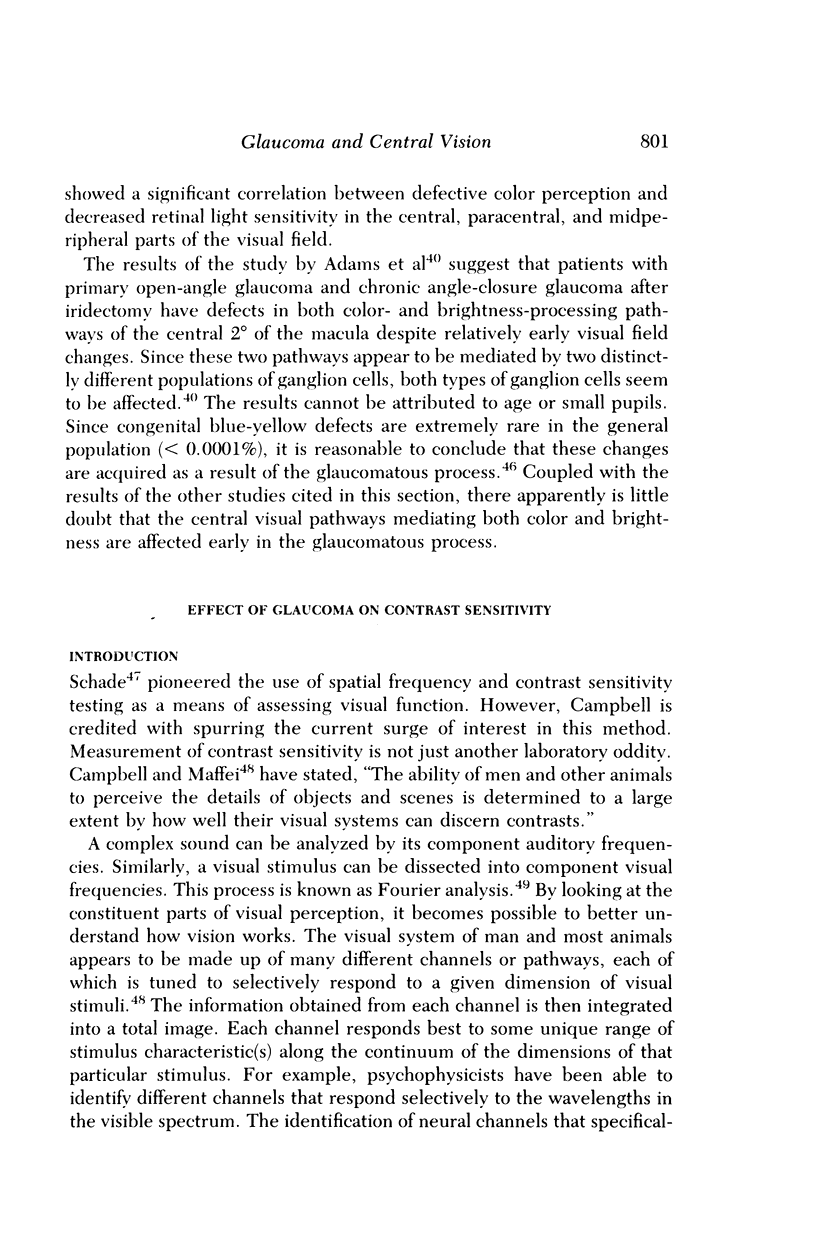
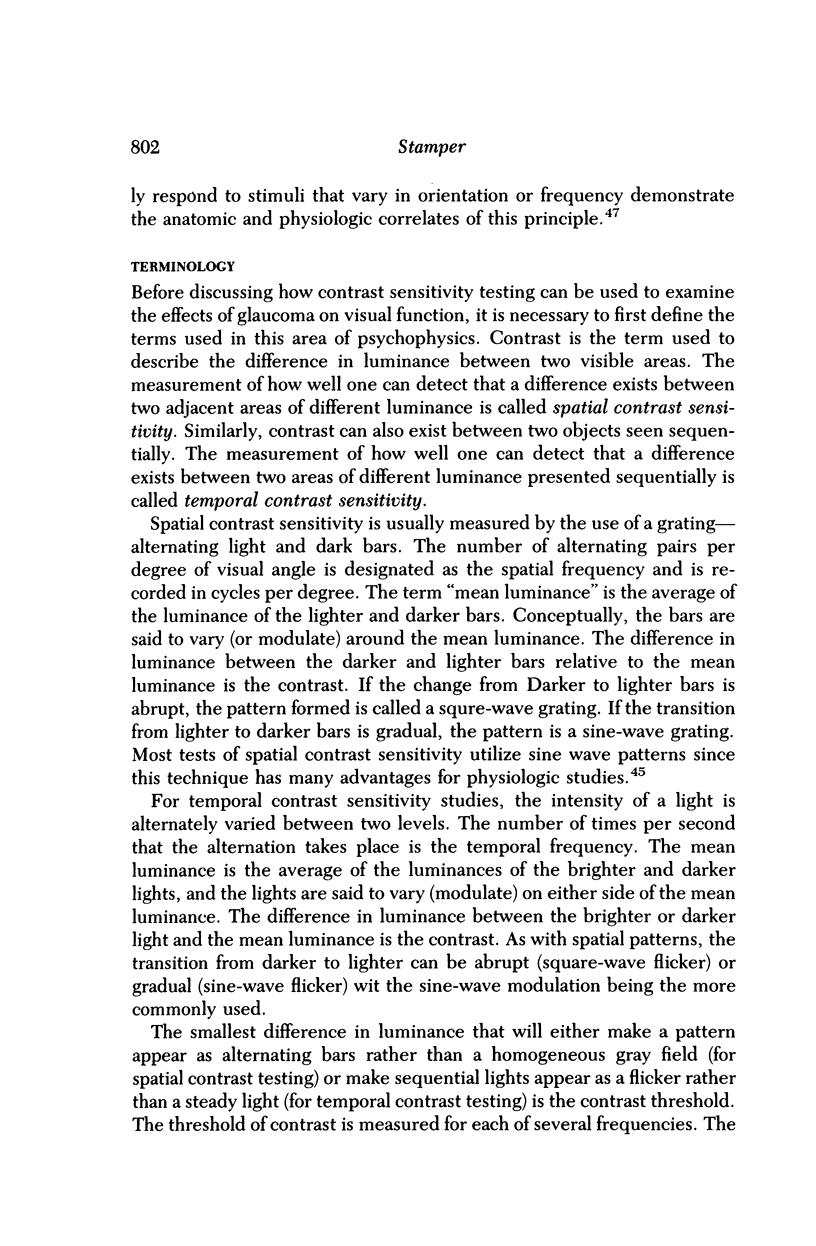
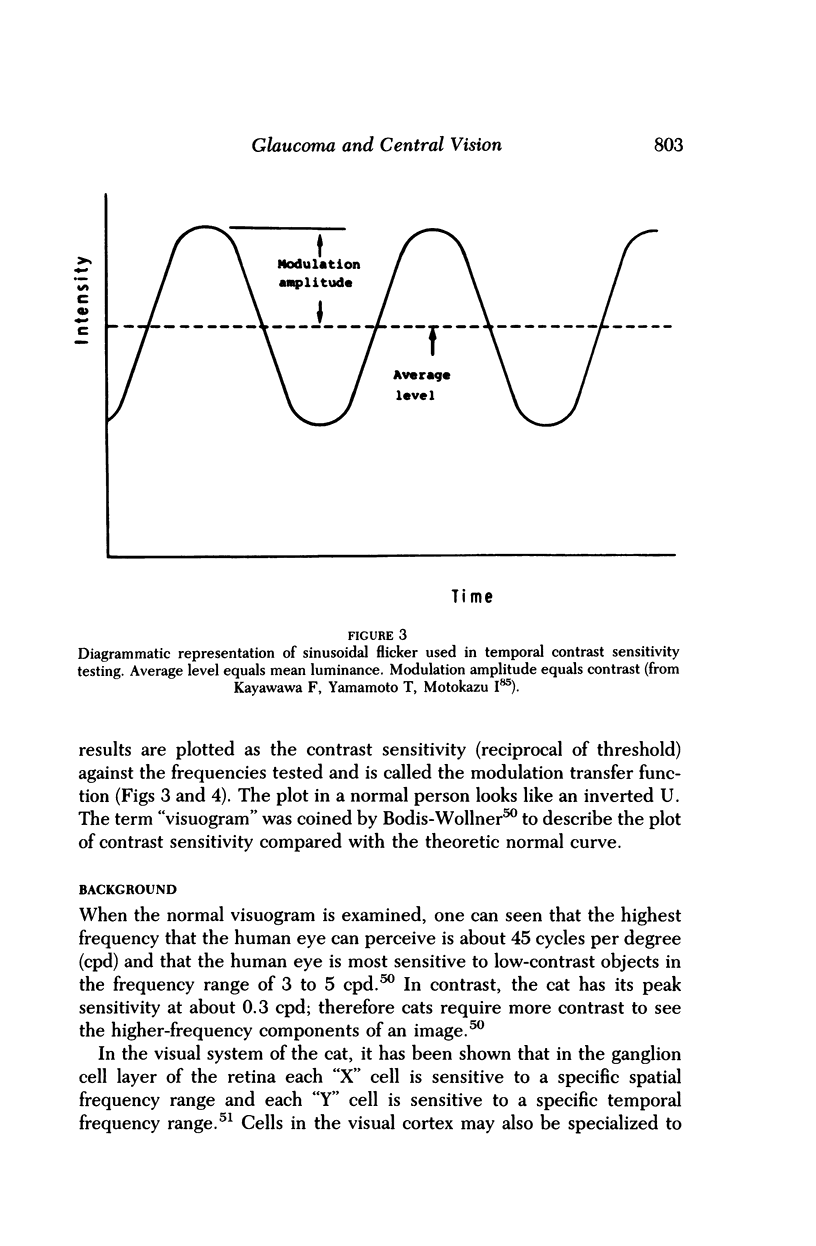
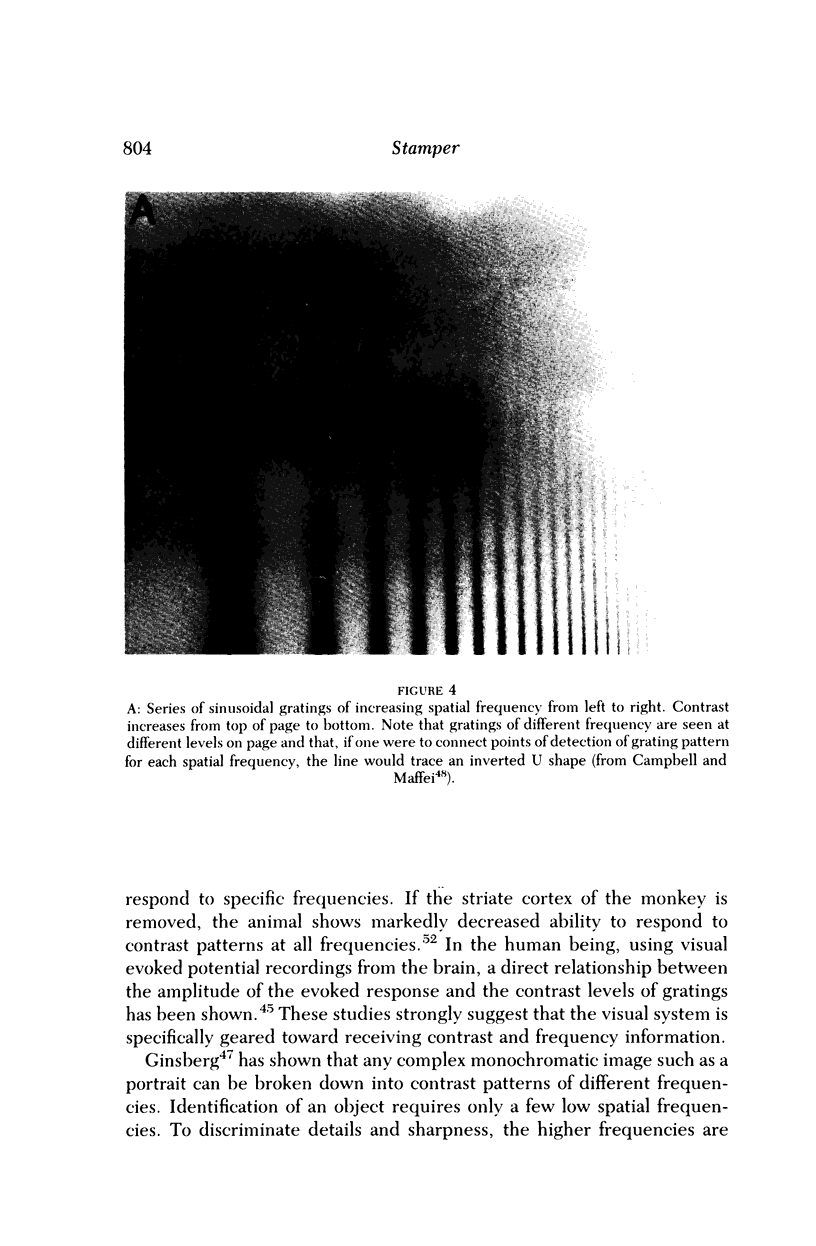
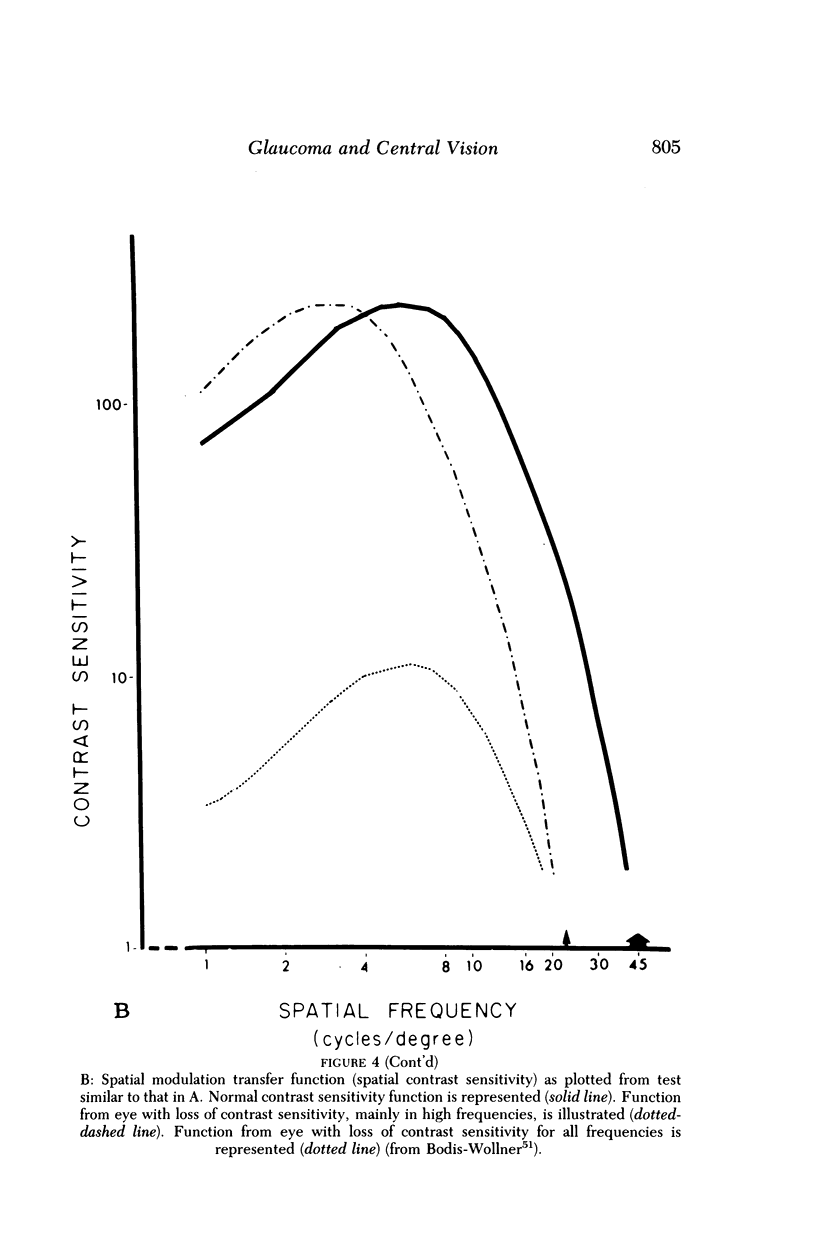
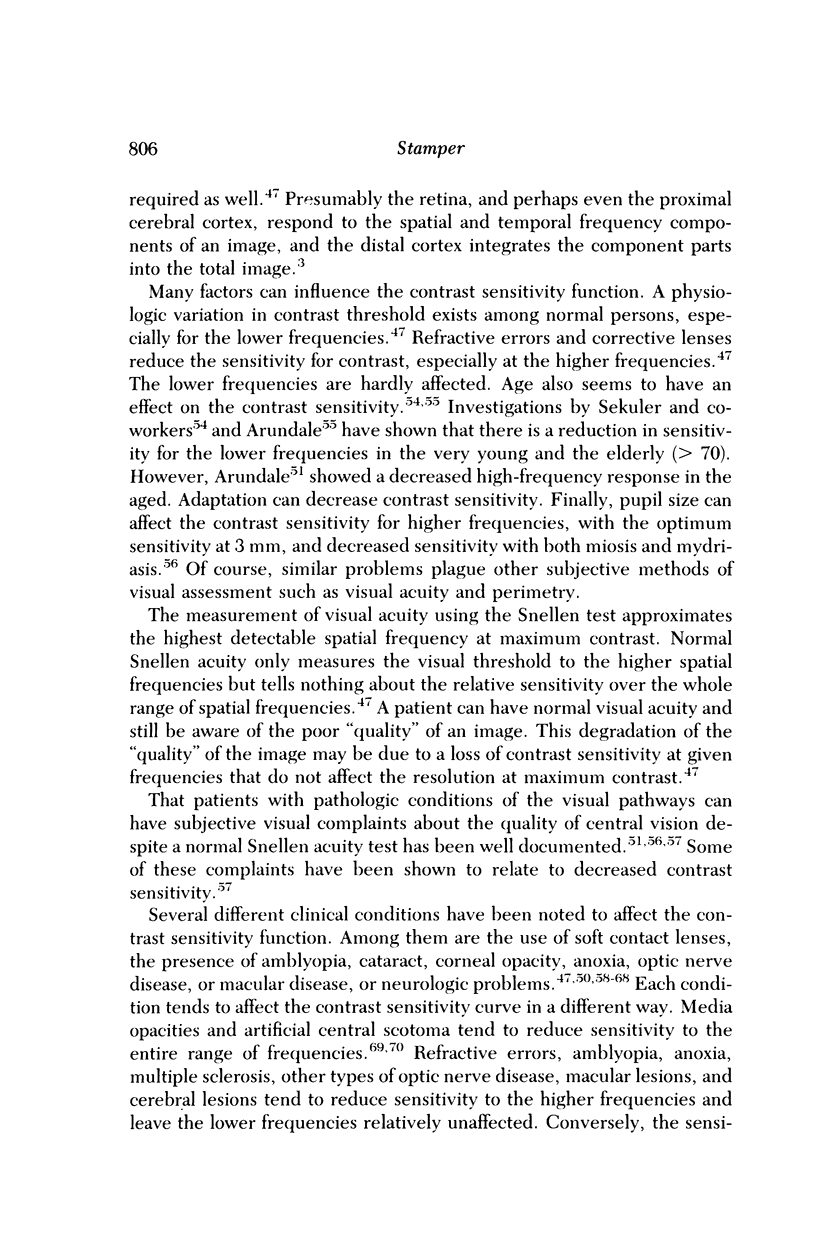
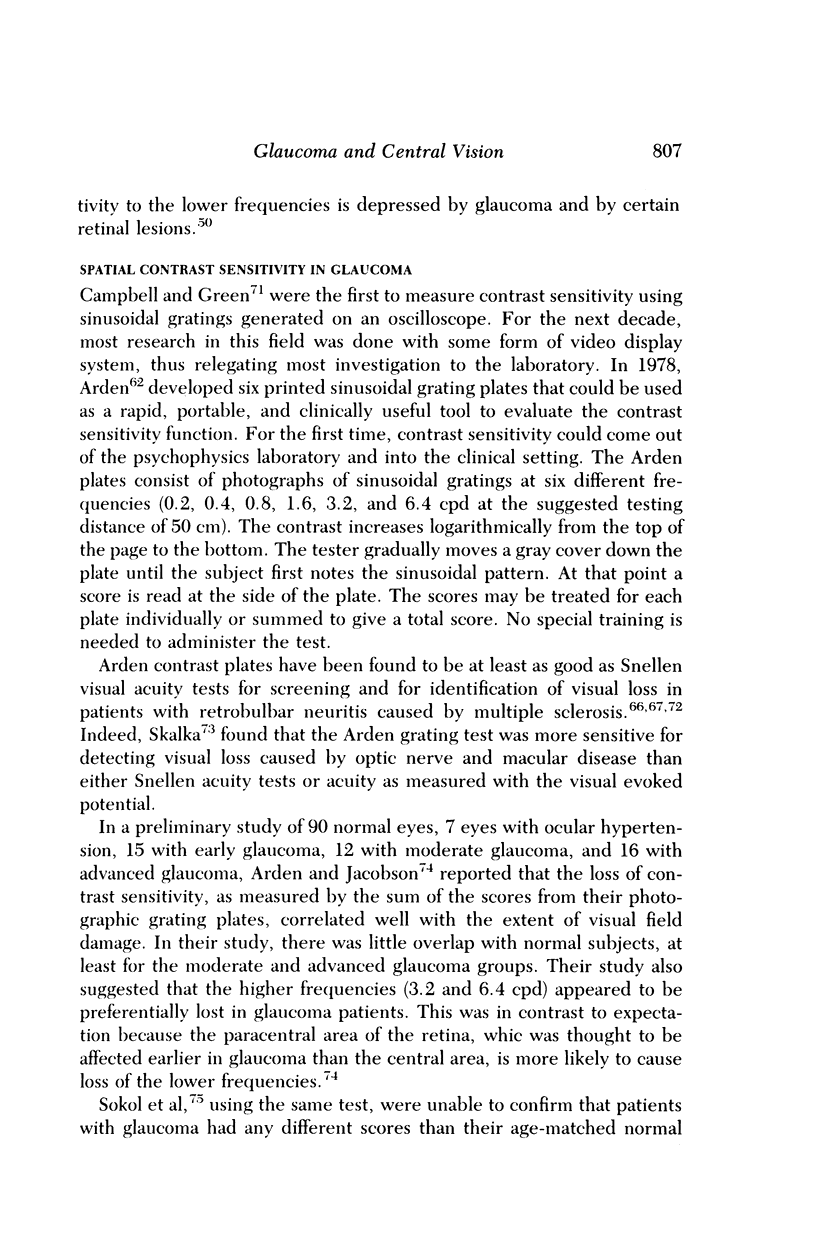
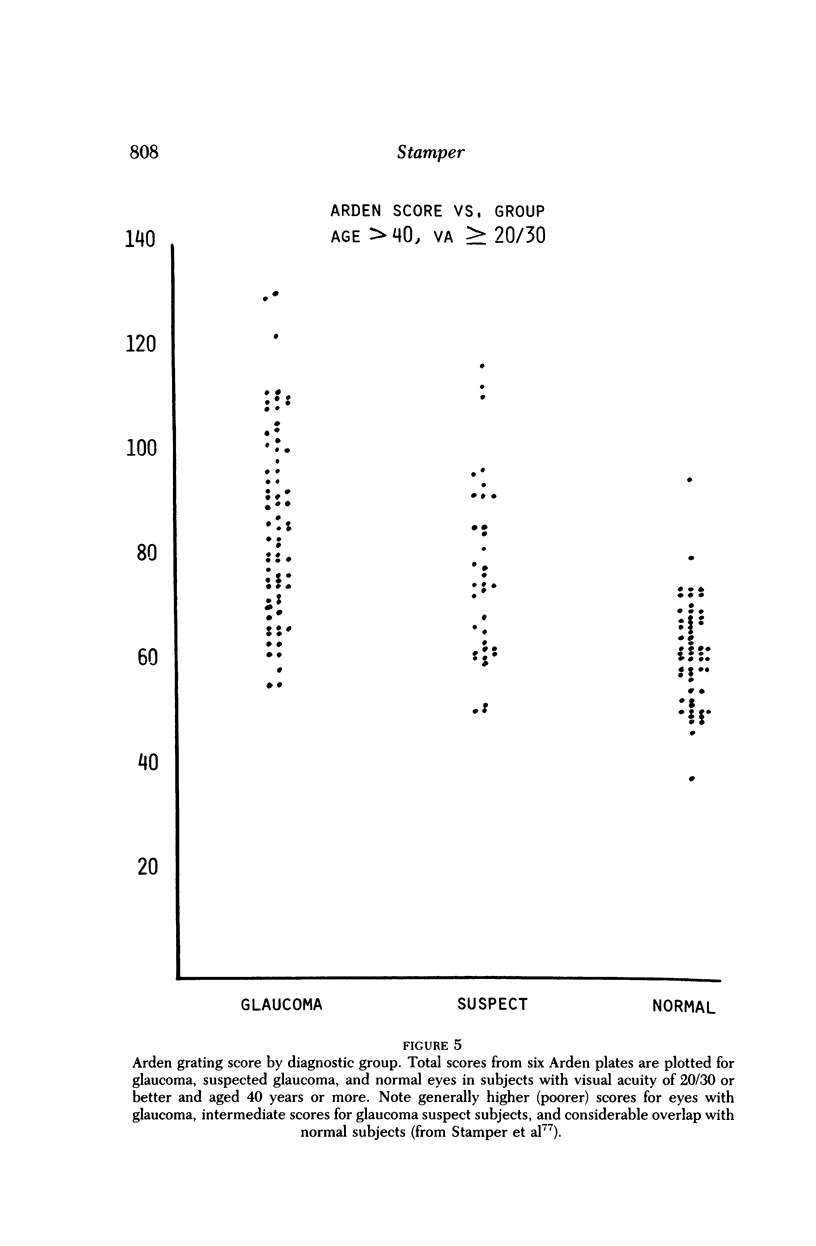
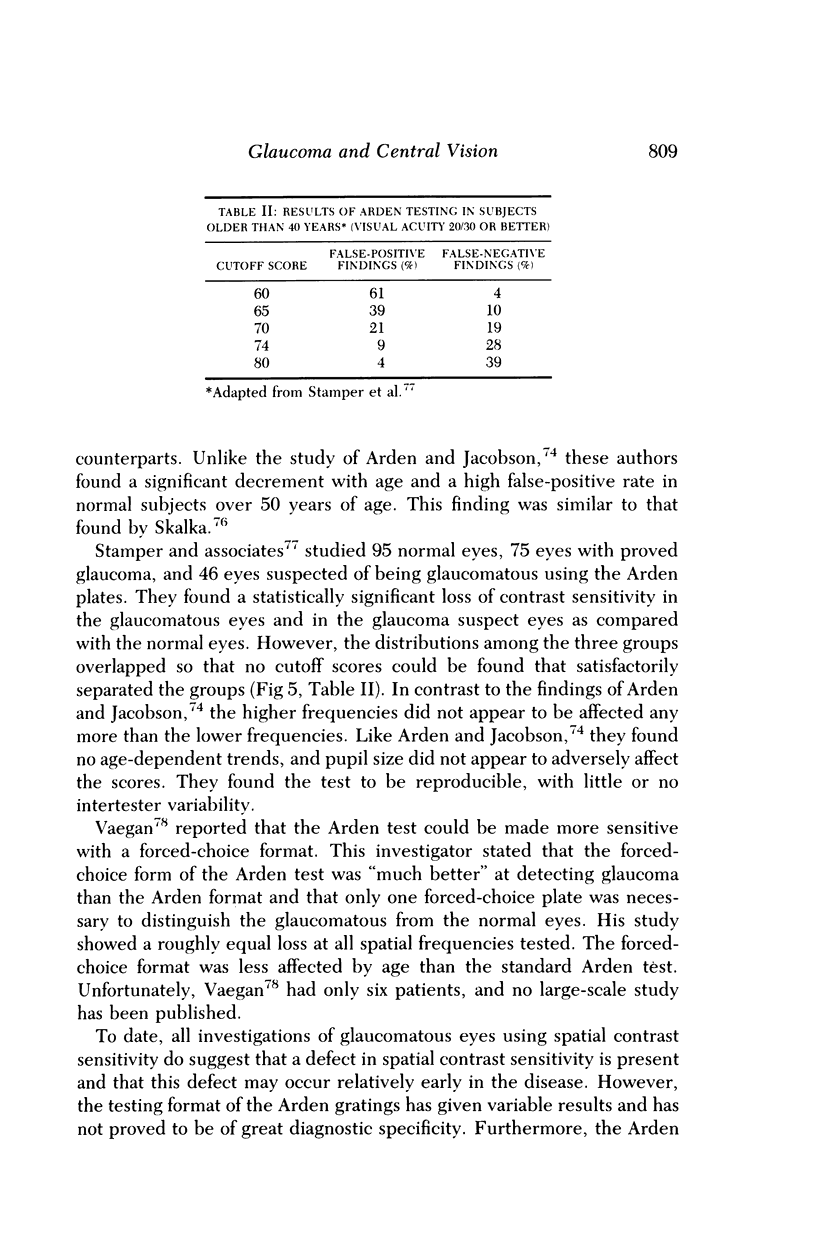
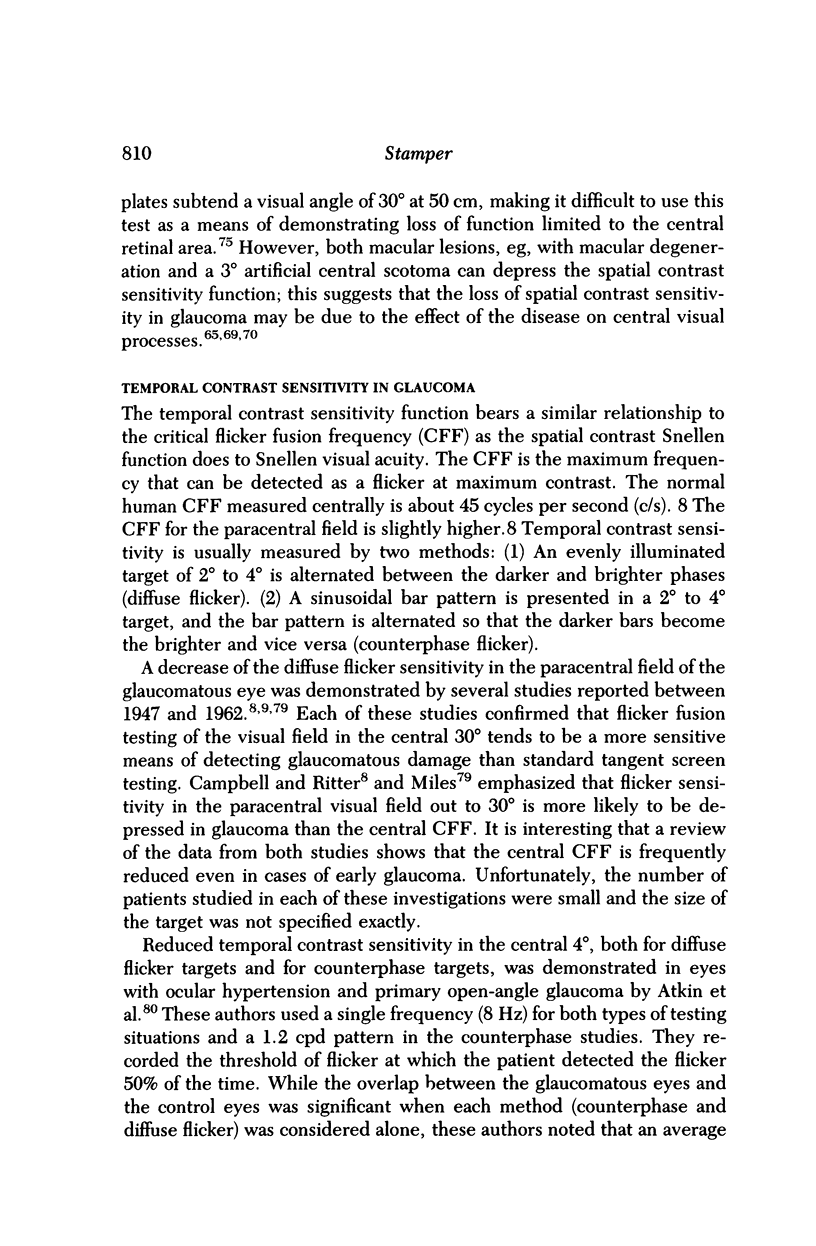
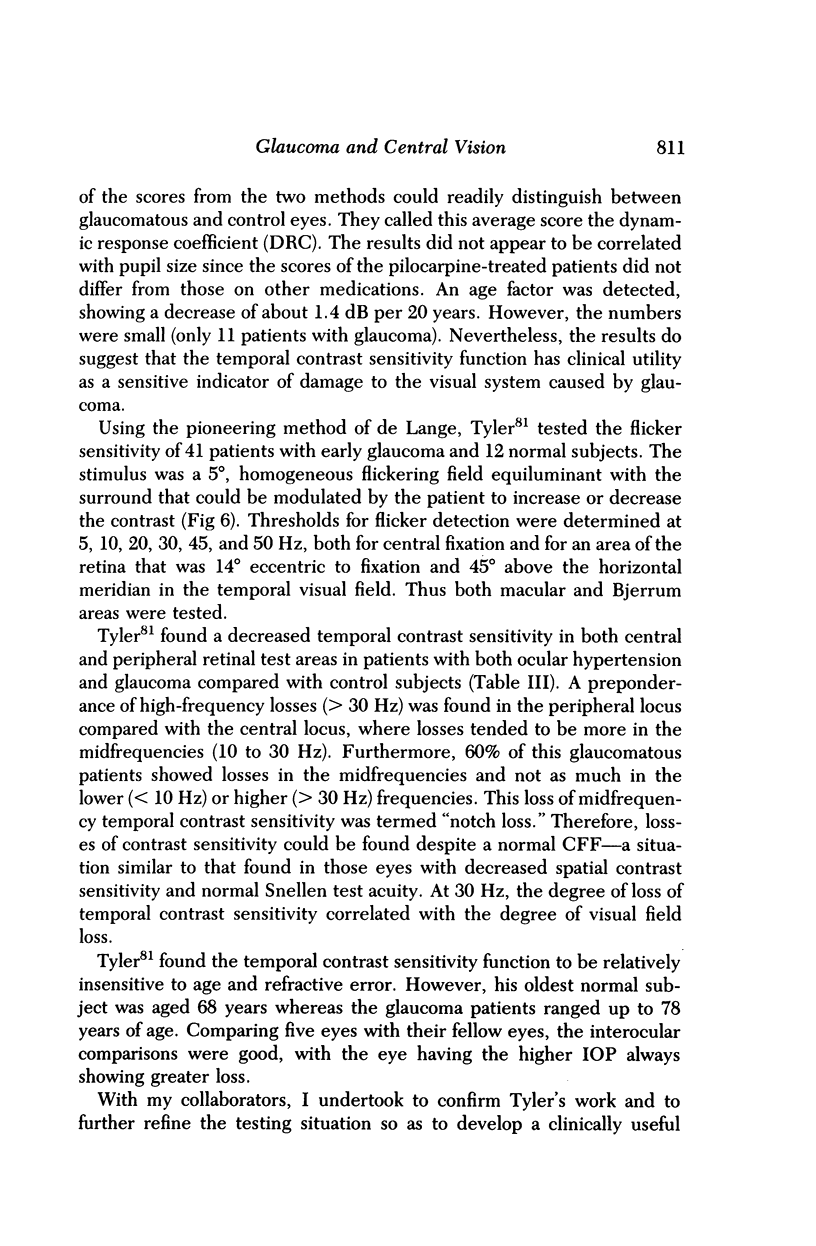
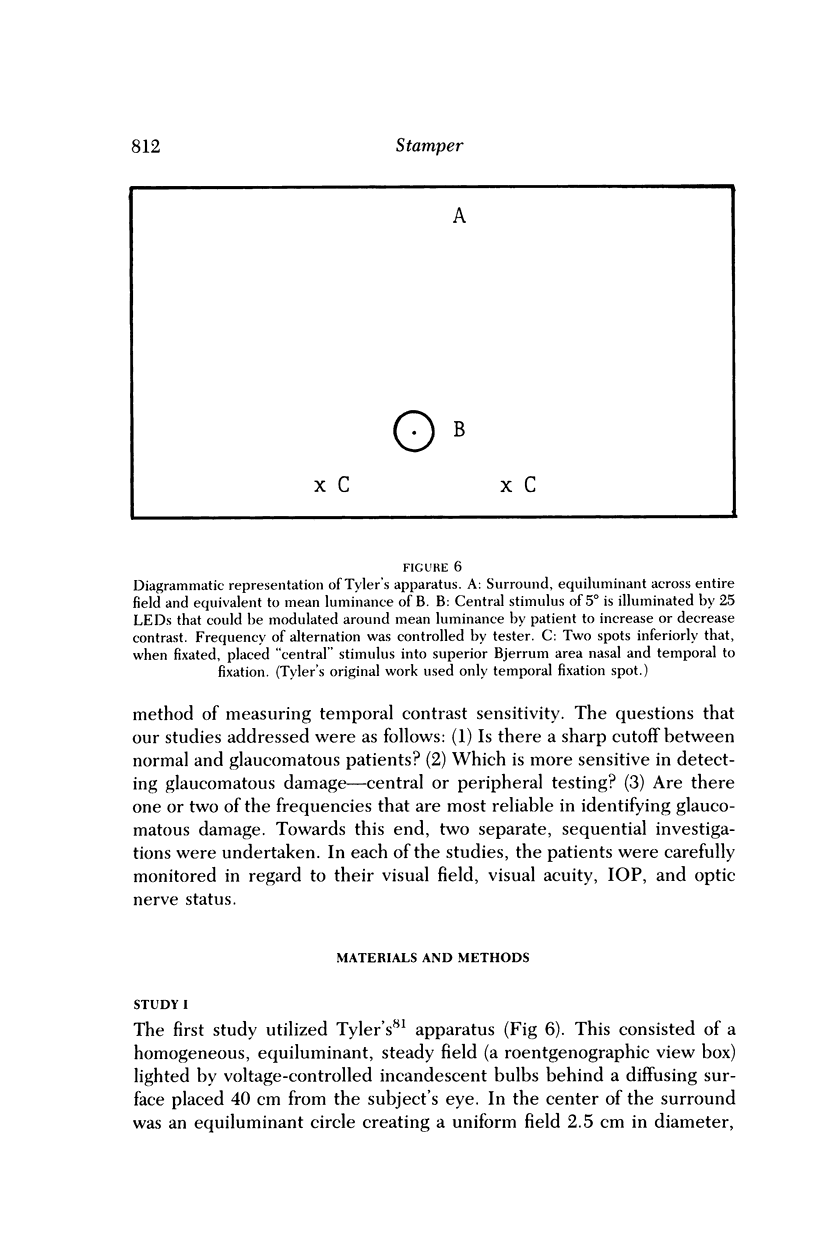
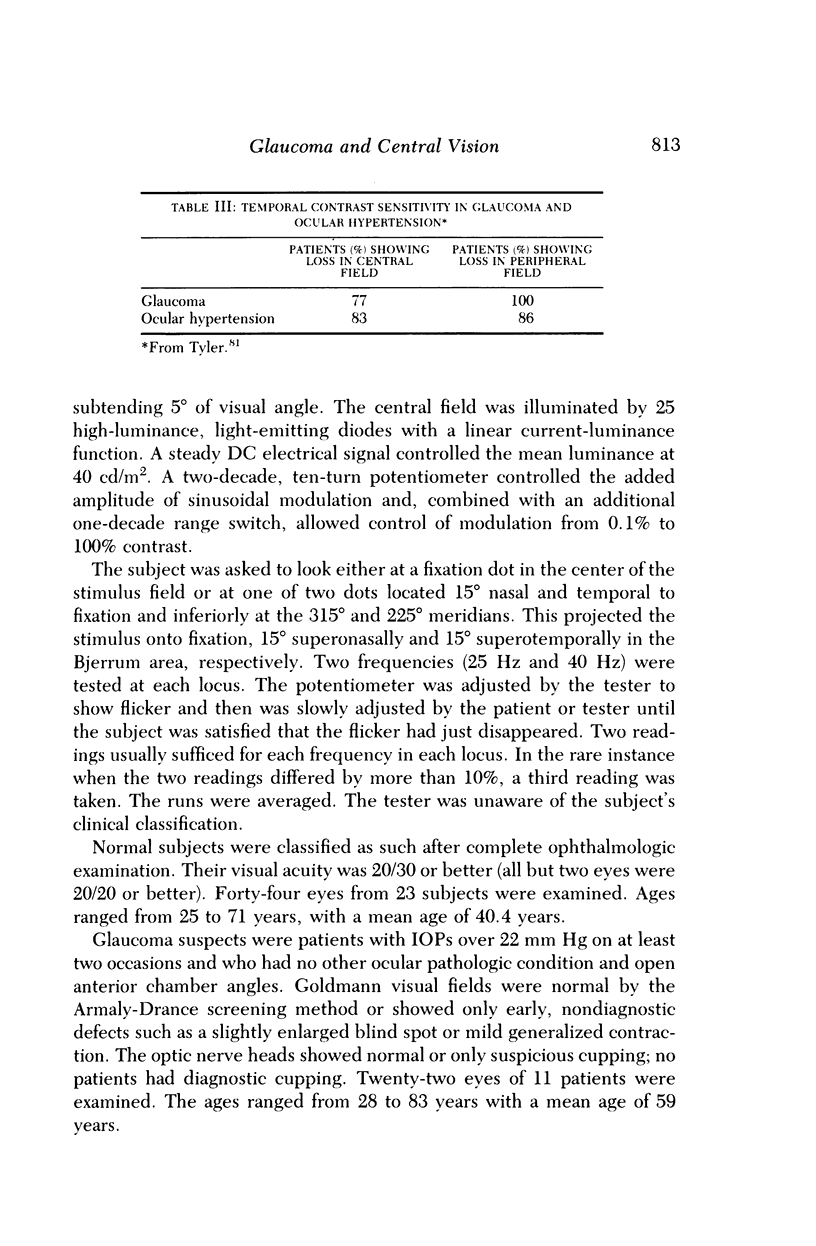
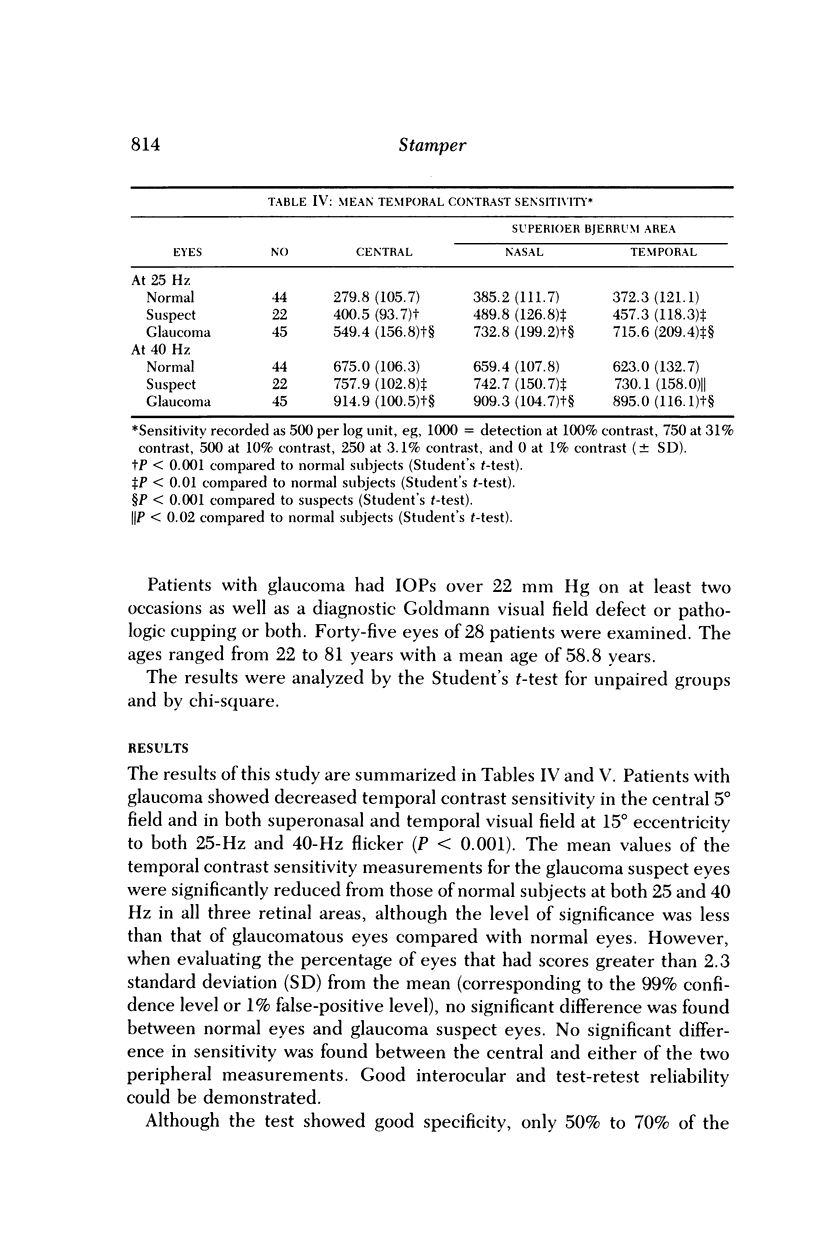
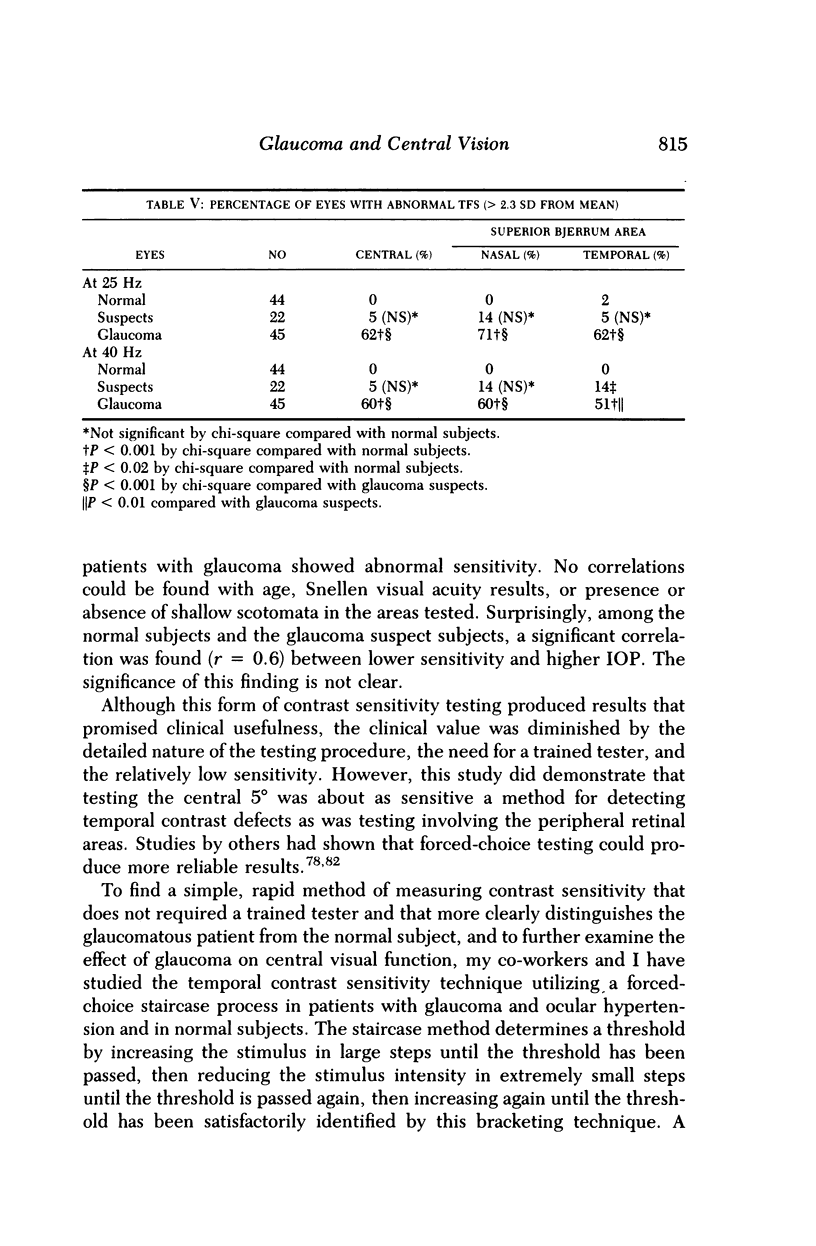
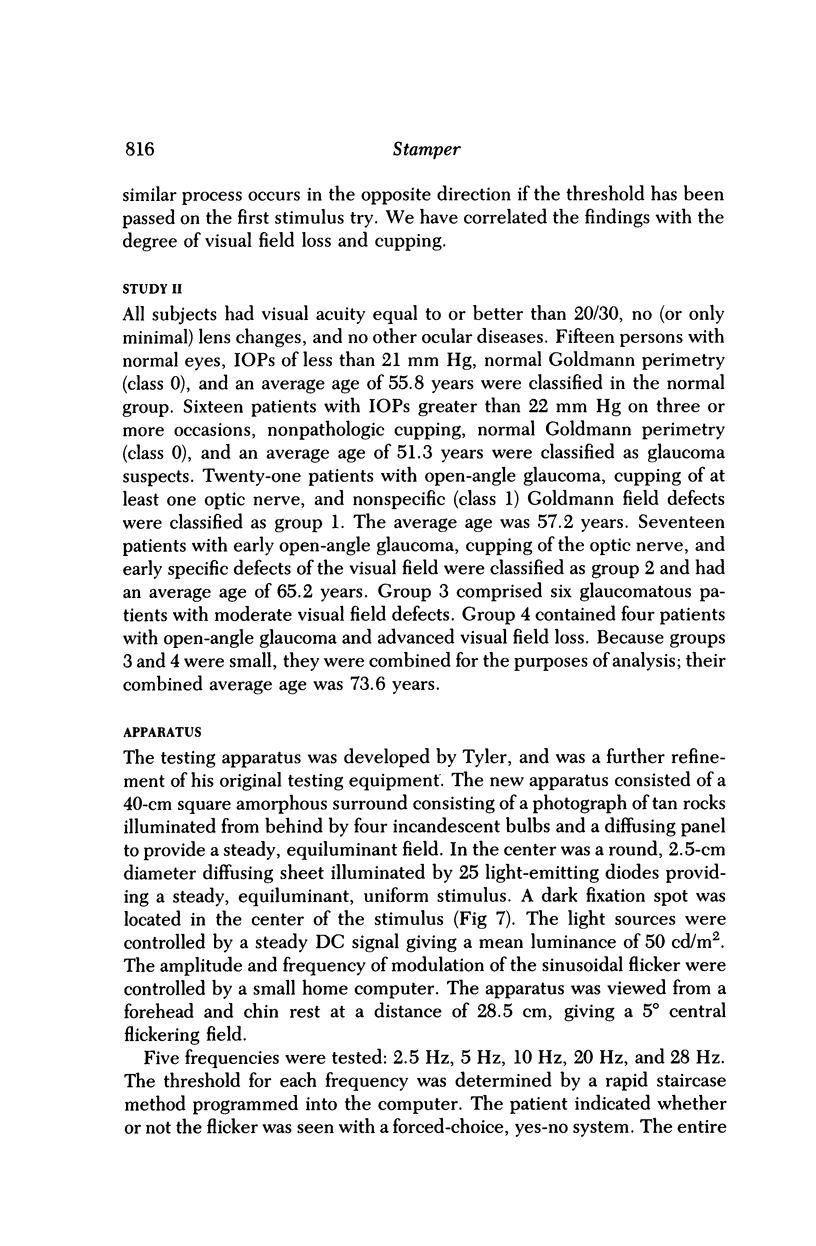
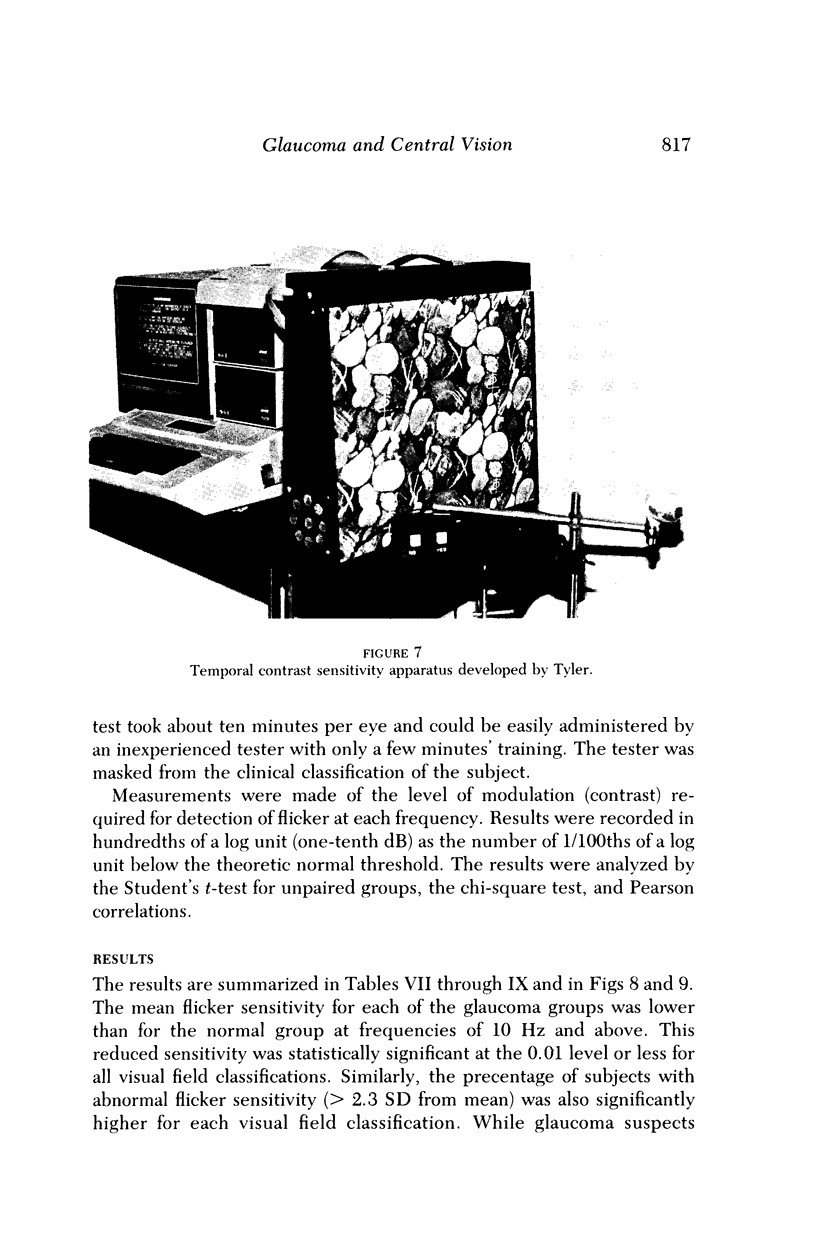
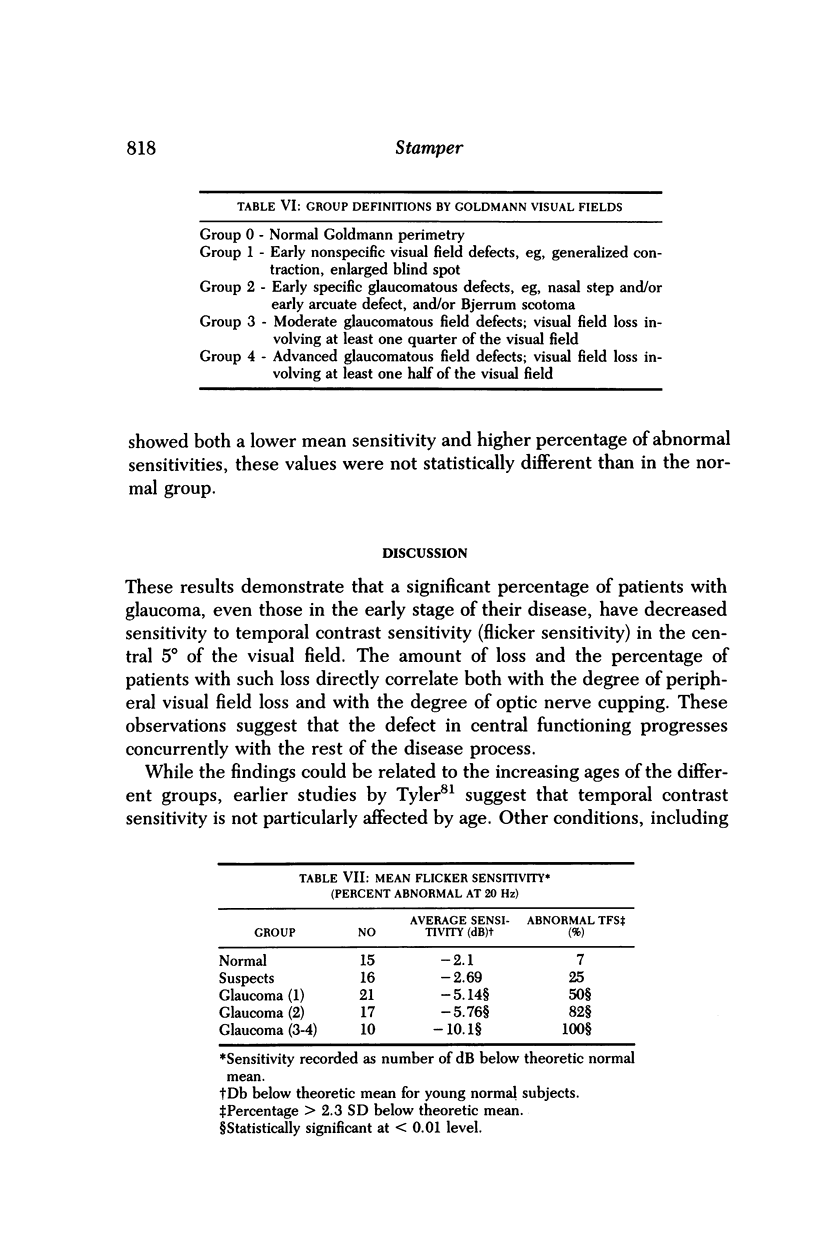
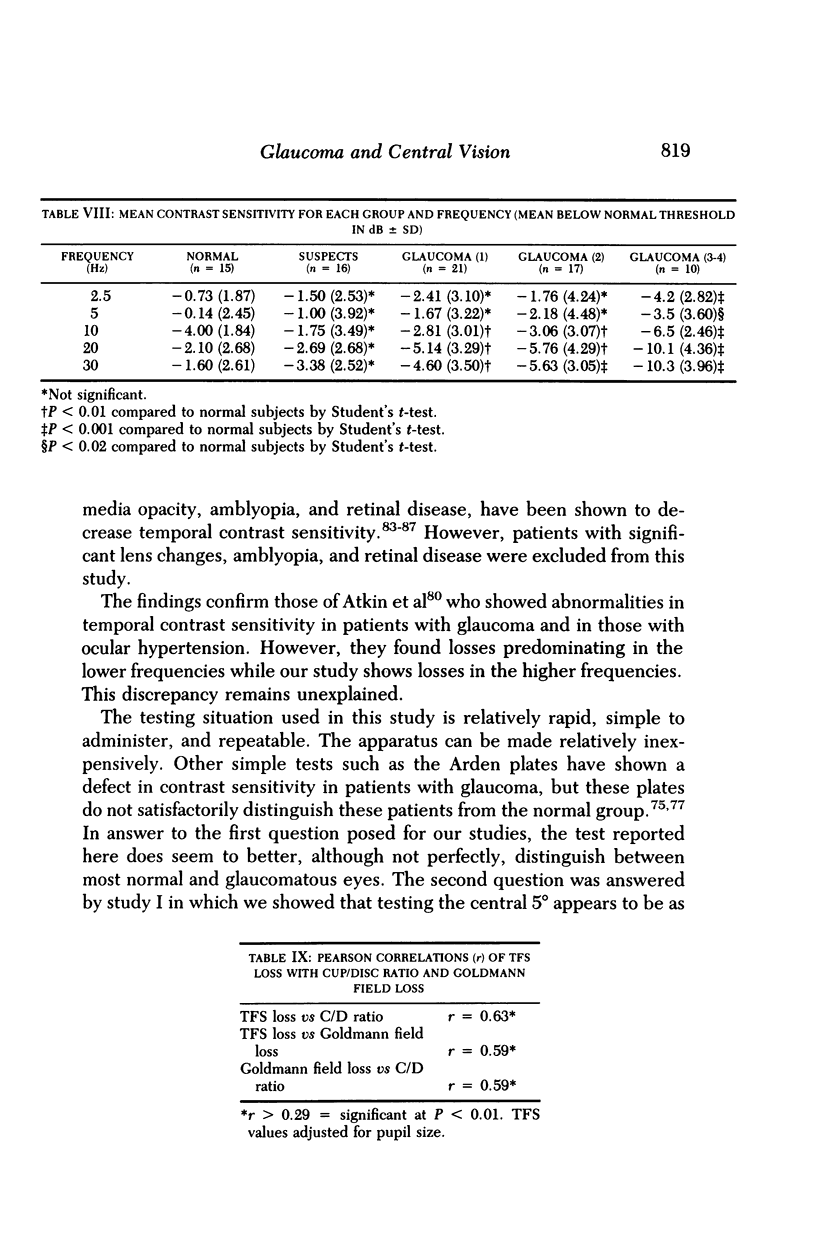
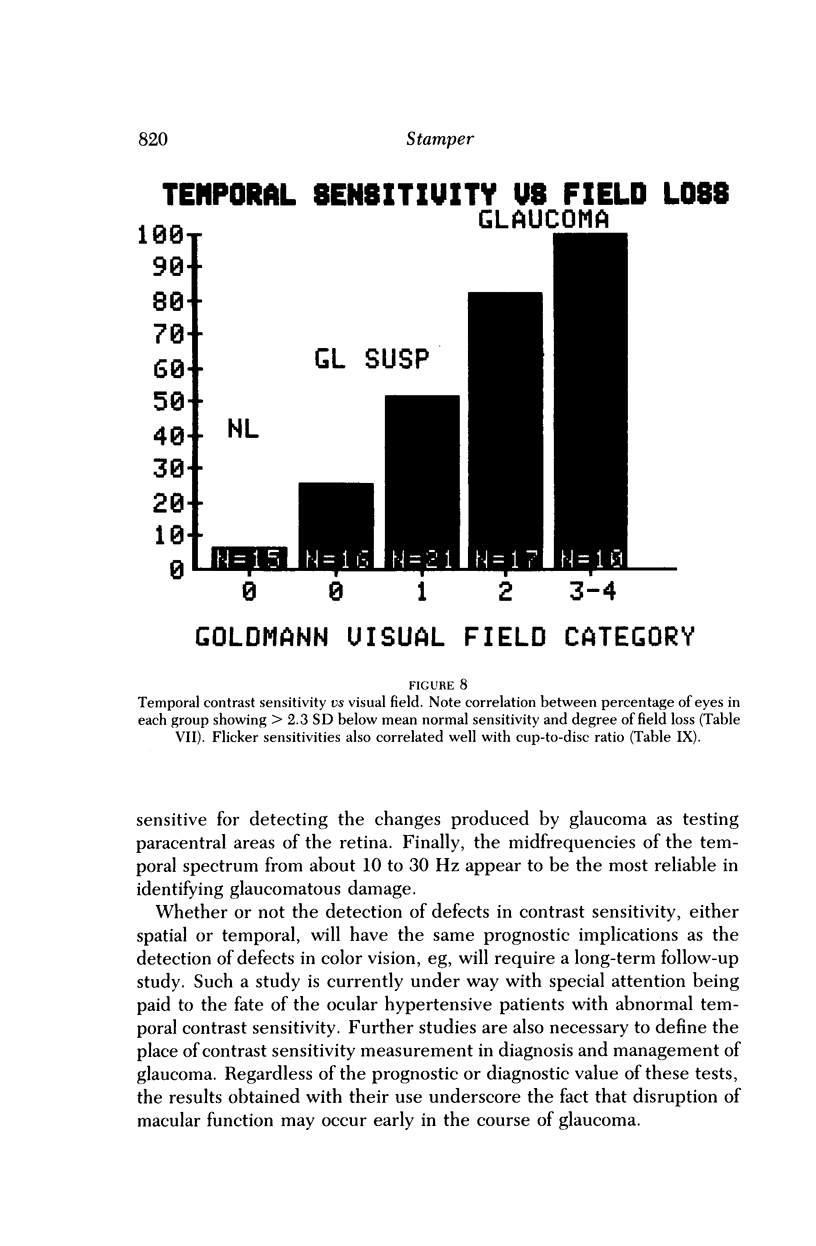
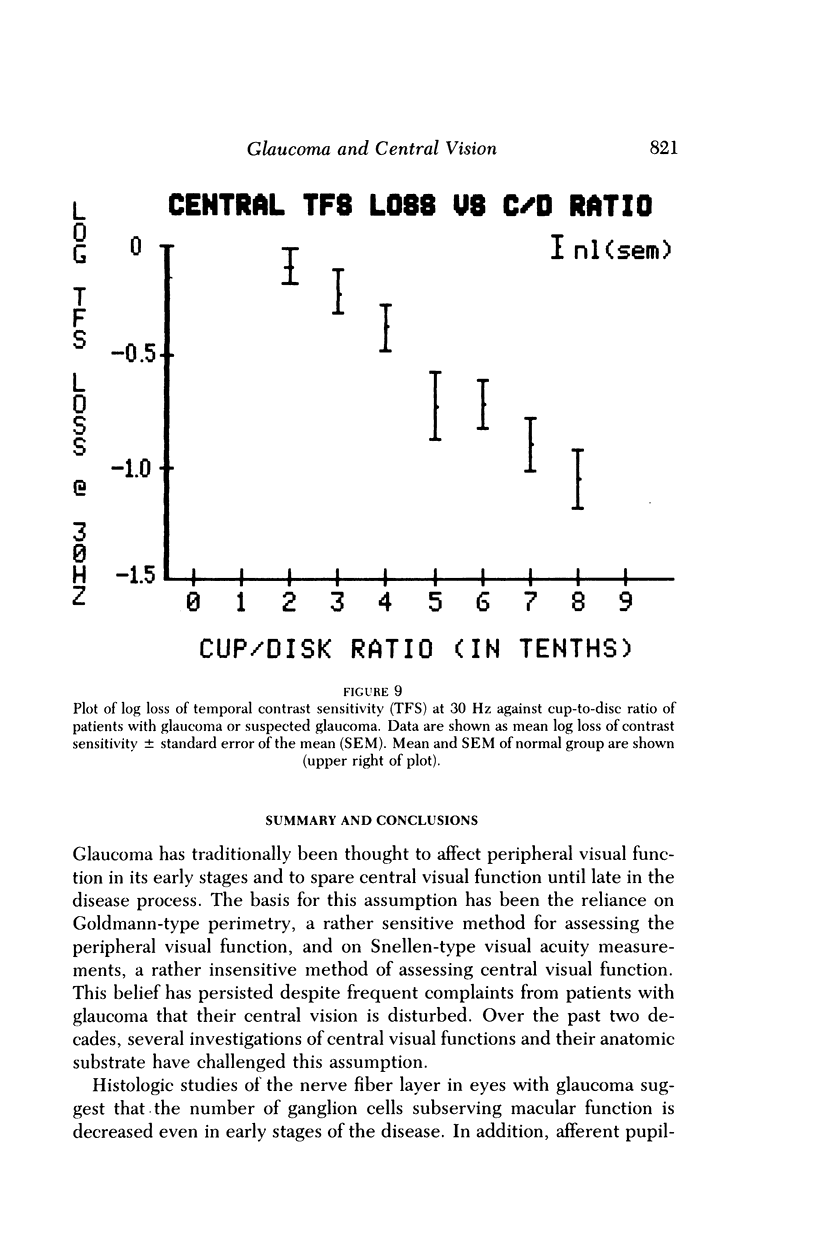
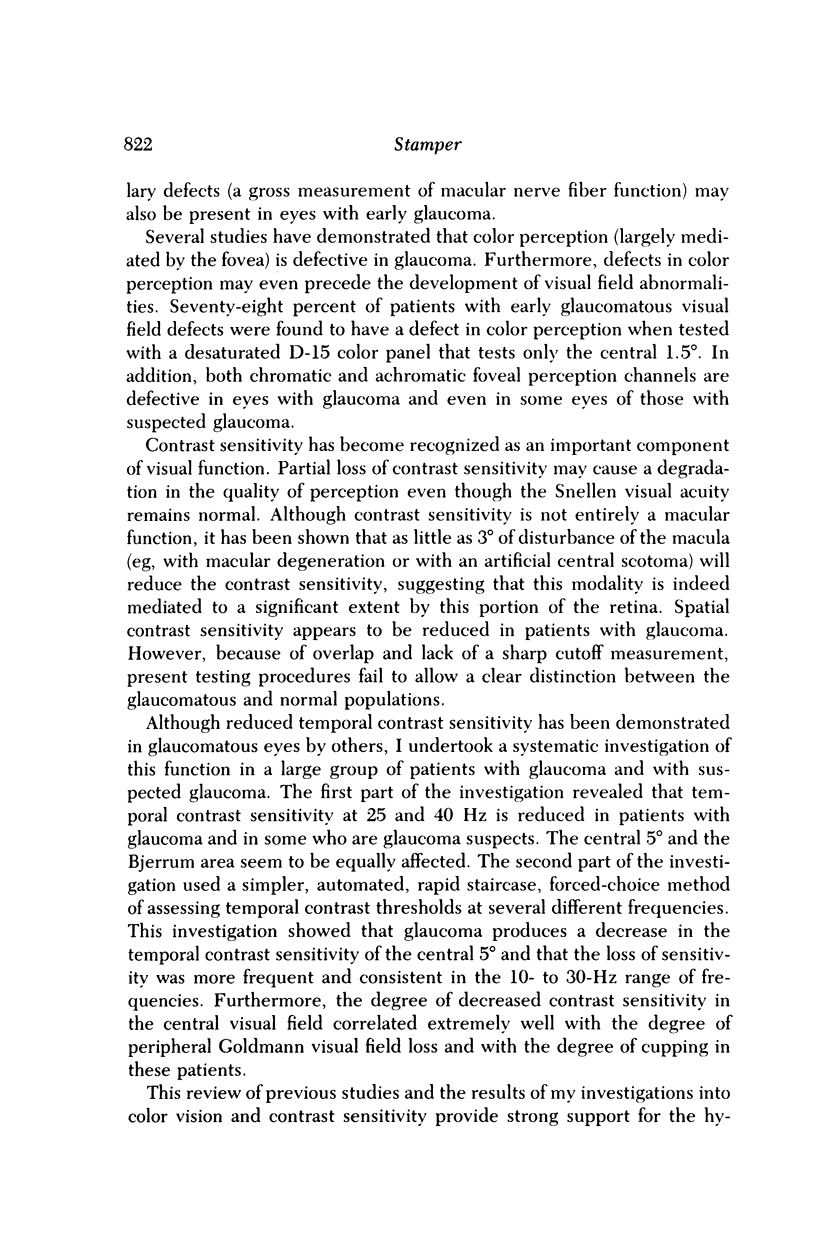
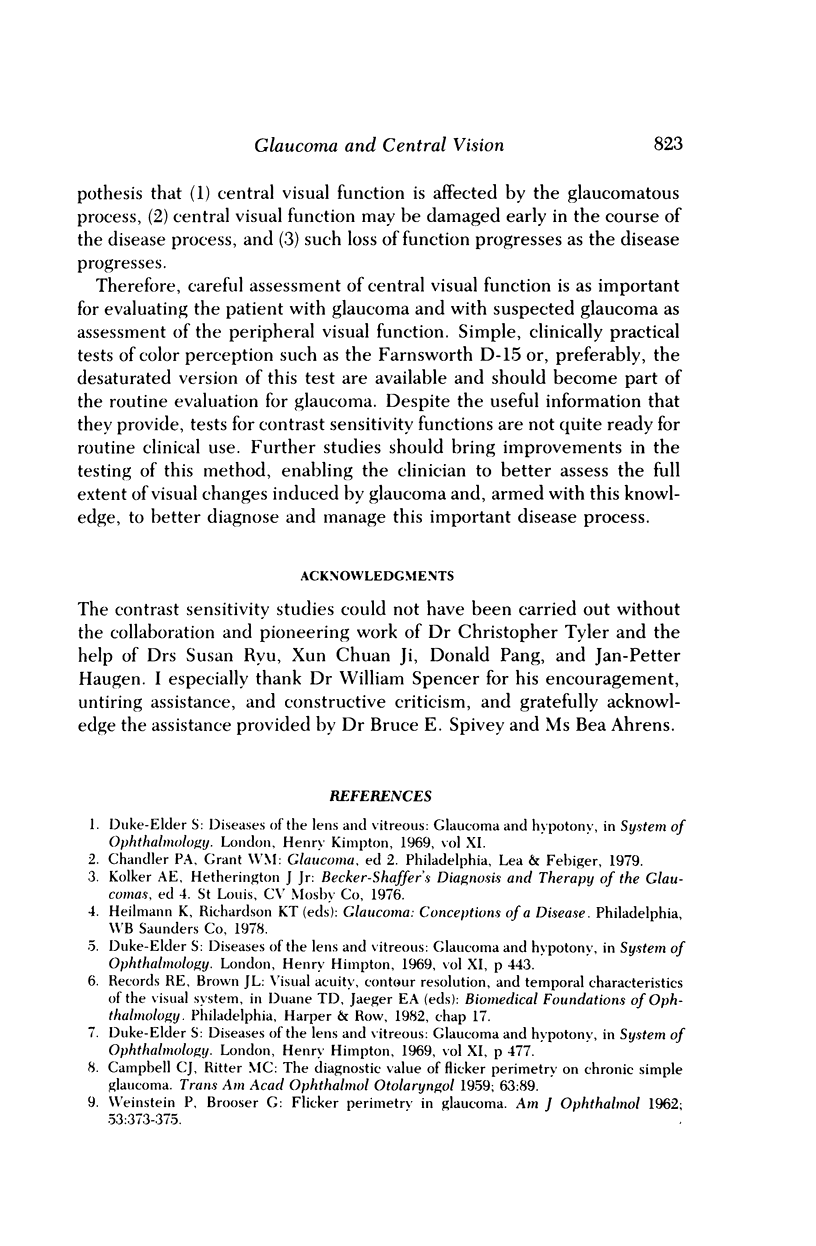
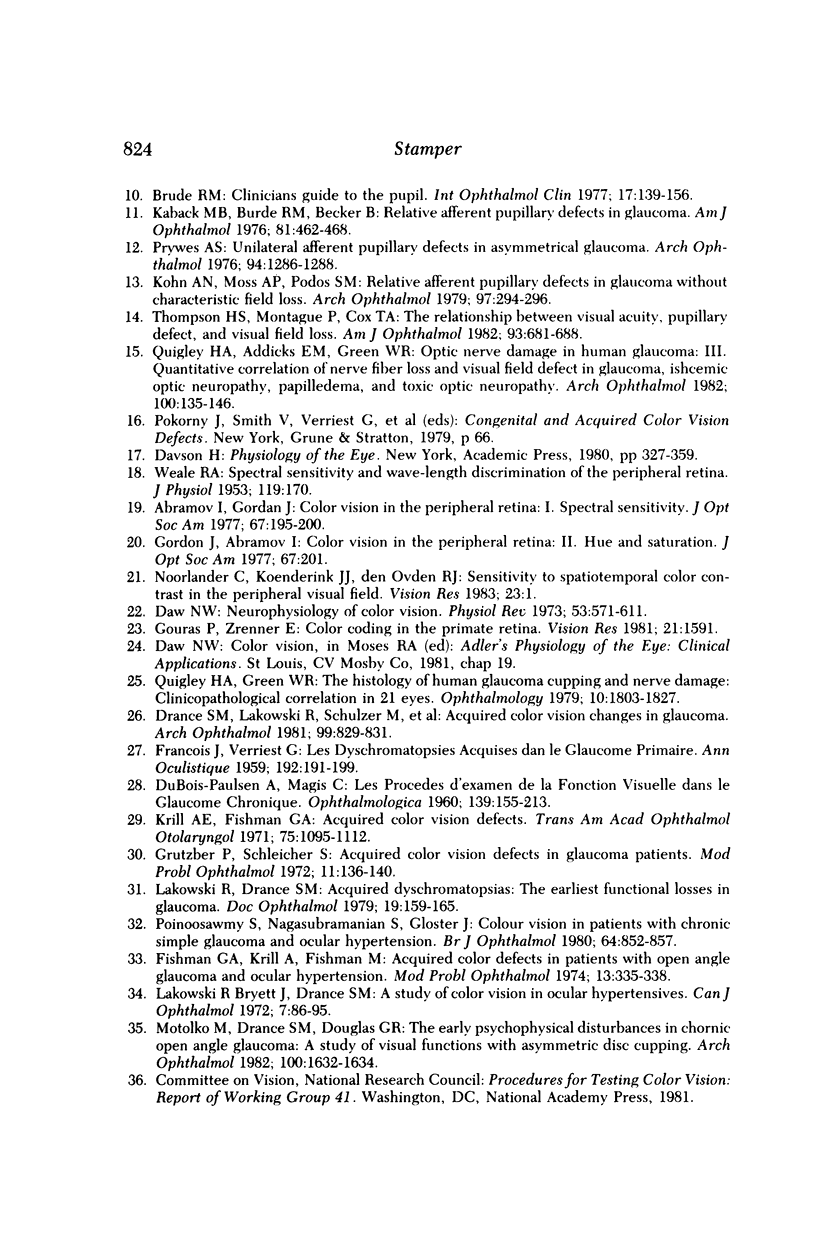
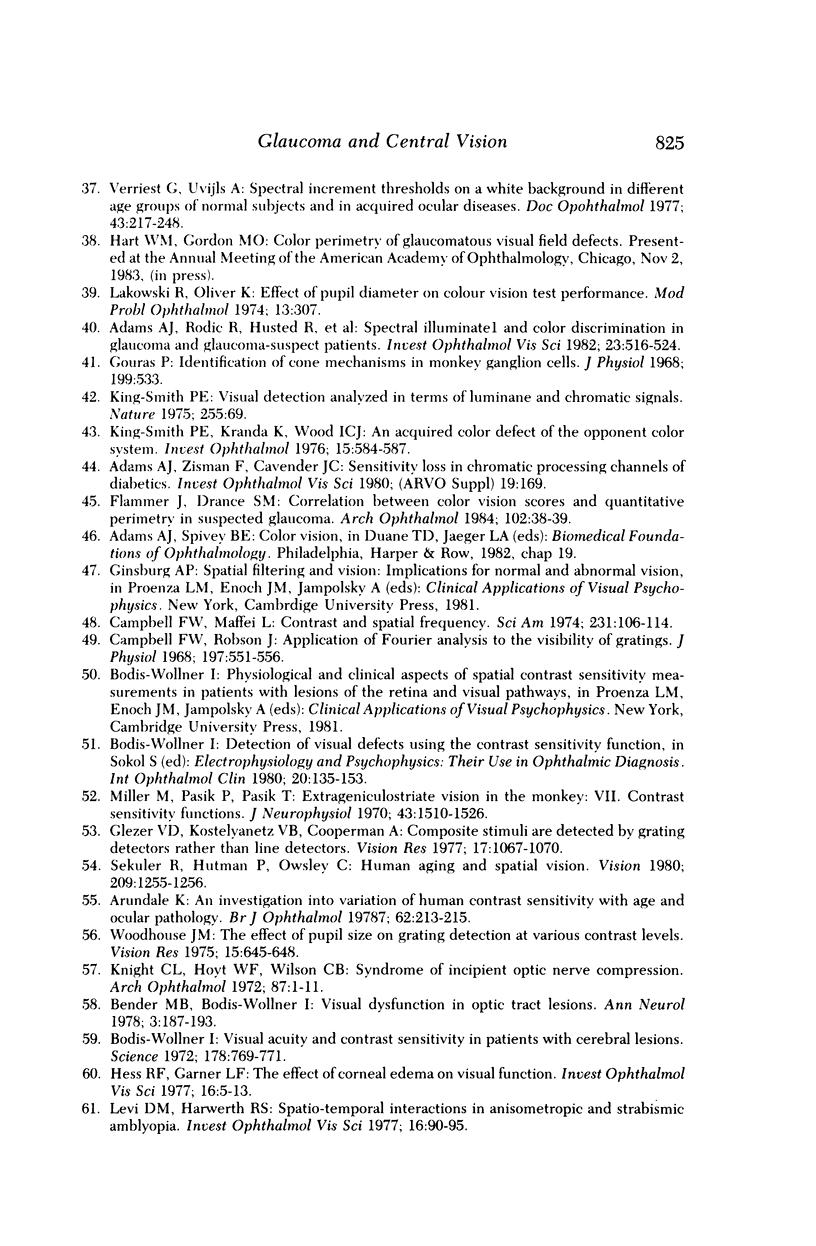
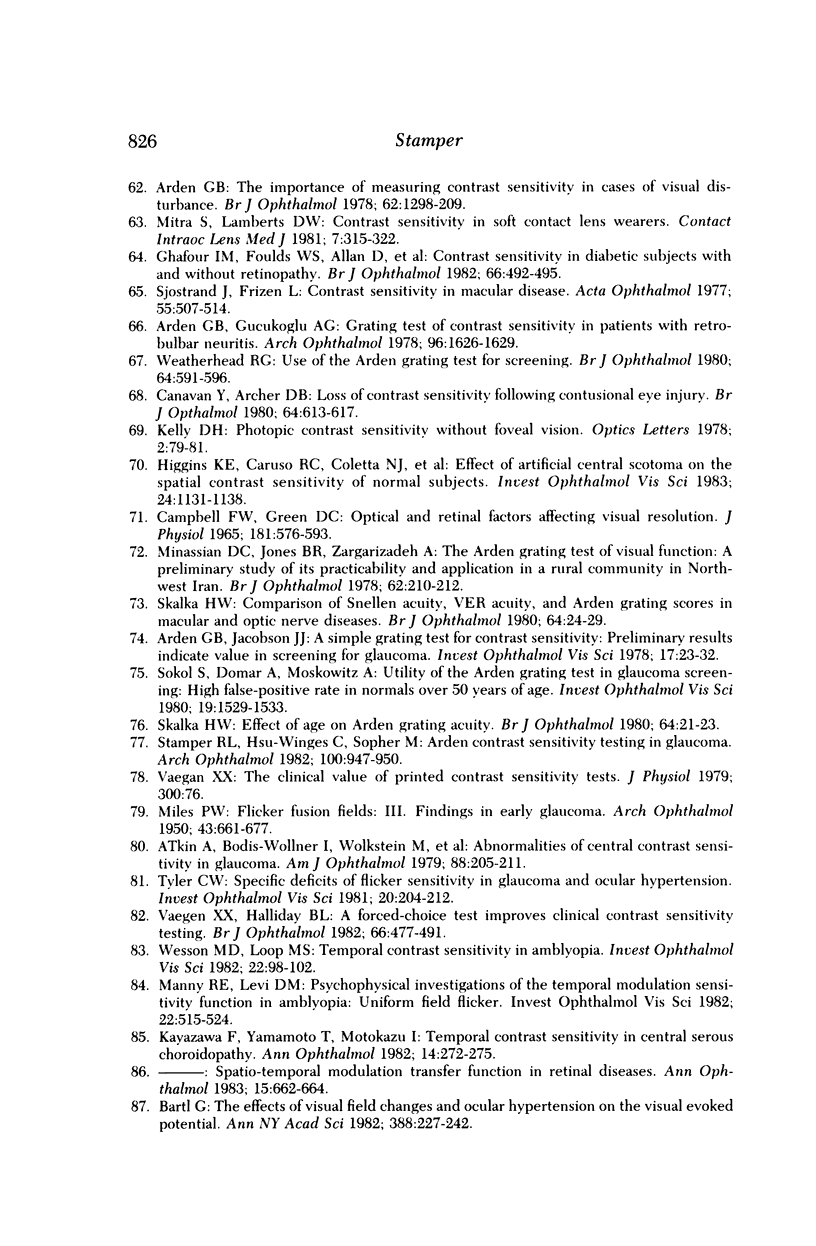
Images in this article
Selected References
These references are in PubMed. This may not be the complete list of references from this article.
- Abramov I., Gordon J. Color vision in the peripheral retina. I. Spectral sensitivity. J Opt Soc Am. 1977 Feb;67(2):195–202. doi: 10.1364/josa.67.000195. [DOI] [PubMed] [Google Scholar]
- Adams A. J., Rodic R., Husted R., Stamper R. Spectral sensitivity and color discrimination changes in glaucoma and glaucoma-suspect patients. Invest Ophthalmol Vis Sci. 1982 Oct;23(4):516–524. [PubMed] [Google Scholar]
- Arden G. B., Gucukoglu A. G. Grating test of contrast sensitivity in patients with retrobulbar neuritis. Arch Ophthalmol. 1978 Sep;96(9):1626–1629. doi: 10.1001/archopht.1978.03910060260015. [DOI] [PubMed] [Google Scholar]
- Arden G. B., Jacobson J. J. A simple grating test for contrast sensitivity: preliminary results indicate value in screening for glaucoma. Invest Ophthalmol Vis Sci. 1978 Jan;17(1):23–32. [PubMed] [Google Scholar]
- Arden G. B. The importance of measuring contrast sensitivity in cases of visual disturbance. Br J Ophthalmol. 1978 Apr;62(4):198–209. doi: 10.1136/bjo.62.4.198. [DOI] [PMC free article] [PubMed] [Google Scholar]
- Atkin A., Bodis-Wollner I., Wolkstein M., Moss A., Podos S. M. Abnormalities of central contrast sensitivity in glaucoma. Am J Ophthalmol. 1979 Aug;88(2):205–211. doi: 10.1016/0002-9394(79)90467-7. [DOI] [PubMed] [Google Scholar]
- Bartl G. The effects of visual field changes and ocular hypertension on the visual evoked potential. Ann N Y Acad Sci. 1982;388:227–242. doi: 10.1111/j.1749-6632.1982.tb50794.x. [DOI] [PubMed] [Google Scholar]
- Bender M. B., Bodis-Wollner I. Visual dysfunctions in optic tract lesions. Ann Neurol. 1978 Mar;3(3):187–193. doi: 10.1002/ana.410030302. [DOI] [PubMed] [Google Scholar]
- Bodis-Wollner I. Visual acuity and contrast sensitivity in patients with cerebral lesions. Science. 1972 Nov 17;178(4062):769–771. doi: 10.1126/science.178.4062.769. [DOI] [PubMed] [Google Scholar]
- Burde R. M. Clinician's guide to the pupil. Int Ophthalmol Clin. 1977 Spring;17(1):139–156. doi: 10.1097/00004397-197701710-00008. [DOI] [PubMed] [Google Scholar]
- CAMPBELL C. J., RITTLER M. C. The diagnostic value of flicker perimetry in chronic simple glaucoma. Trans Am Acad Ophthalmol Otolaryngol. 1959 Jan-Feb;63(1):89–98. [PubMed] [Google Scholar]
- Campbell F. W., Green D. G. Optical and retinal factors affecting visual resolution. J Physiol. 1965 Dec;181(3):576–593. doi: 10.1113/jphysiol.1965.sp007784. [DOI] [PMC free article] [PubMed] [Google Scholar]
- Campbell F. W., Maffei L. Contrast and spatial frequency. Sci Am. 1974 Nov;231(5):106–114. doi: 10.1038/scientificamerican1174-106. [DOI] [PubMed] [Google Scholar]
- Campbell F. W., Robson J. G. Application of Fourier analysis to the visibility of gratings. J Physiol. 1968 Aug;197(3):551–566. doi: 10.1113/jphysiol.1968.sp008574. [DOI] [PMC free article] [PubMed] [Google Scholar]
- Canavan Y., Archer D. B. Loss of contrast sensitivity following contusional eye injury. Br J Ophthalmol. 1980 Aug;64(8):613–617. doi: 10.1136/bjo.64.8.613. [DOI] [PMC free article] [PubMed] [Google Scholar]
- DUBOIS-POULSEN A., MAGIS C. [Procedures for the examination of visual function in chronic glaucoma]. Ophthalmologica. 1960 Mar-Apr;139:155–213. doi: 10.1159/000303700. [DOI] [PubMed] [Google Scholar]
- Daw N. W. Neurophysiology of color vision. Physiol Rev. 1973 Jul;53(3):571–611. doi: 10.1152/physrev.1973.53.3.571. [DOI] [PubMed] [Google Scholar]
- Drance S. M., Lakowski R., Schulzer M., Douglas G. R. Acquired color vision changes in glaucoma. Use of 100-hue test and Pickford anomaloscope as predictors of glaucomatous field change. Arch Ophthalmol. 1981 May;99(5):829–831. doi: 10.1001/archopht.1981.03930010829007. [DOI] [PubMed] [Google Scholar]
- FRANCOIS J., VERRIEST G. Les dyschromatopsies acquises dans le glancome primaire. Ann Ocul (Paris) 1959 Mar;192(3):191–199. [PubMed] [Google Scholar]
- Fishman G. A., Krill A. E., Fishman M. Acquired color defects in patients with open-angle glaucoma and ocular hypertension. Mod Probl Ophthalmol. 1974;13(0):335–338. [PubMed] [Google Scholar]
- Flammer J., Drance S. M. Correlation between color vision scores and quantitative perimetry in suspected glaucoma. Arch Ophthalmol. 1984 Jan;102(1):38–39. doi: 10.1001/archopht.1984.01040030022026. [DOI] [PubMed] [Google Scholar]
- Ghafour I. M., Foulds W. S., Allan D., McClure E. Contrast sensitivity in diabetic subjects with and without retinopathy. Br J Ophthalmol. 1982 Aug;66(8):492–495. doi: 10.1136/bjo.66.8.492. [DOI] [PMC free article] [PubMed] [Google Scholar]
- Glezer V. D., Kostelyanets N. B., Cooperman A. M. Composite stimuli are detected by grating detectors rather than by line detectors. Vision Res. 1977;17(9):1067–1070. doi: 10.1016/0042-6989(77)90011-6. [DOI] [PubMed] [Google Scholar]
- Gouras P. Identification of cone mechanisms in monkey ganglion cells. J Physiol. 1968 Dec;199(3):533–547. doi: 10.1113/jphysiol.1968.sp008667. [DOI] [PMC free article] [PubMed] [Google Scholar]
- Gouras P., Zrenner E. Color coding in primate retina. Vision Res. 1981;21(11):1591–1598. doi: 10.1016/0042-6989(81)90039-0. [DOI] [PubMed] [Google Scholar]
- Grützner P., Schleicher S. Acquired color vision defects in glaucoma patients. Mod Probl Ophthalmol. 1972;11:136–140. [PubMed] [Google Scholar]
- Hess R. F., Garner L. F. The effect of corneal edema on visual function. Invest Ophthalmol Vis Sci. 1977 Jan;16(1):5–13. [PubMed] [Google Scholar]
- Higgins K. E., Caruso R. C., Coletta N. J., de Monasterio F. M. Effect of artificial central scotoma on the spatial contrast sensitivity of normal subjects. Invest Ophthalmol Vis Sci. 1983 Aug;24(8):1131–1138. [PubMed] [Google Scholar]
- Kaback M. B., Burde R. M., Becker B. Relative afferent pupillary defect in glaucoma. Am J Ophthalmol. 1976 Apr;81(4):462–468. doi: 10.1016/0002-9394(76)90302-0. [DOI] [PubMed] [Google Scholar]
- Kayazawa F., Yamamoto T., Itoi M. Temporal contrast sensitivity in central serous choroidopathy. Ann Ophthalmol. 1982 Mar;14(3):272–275. [PubMed] [Google Scholar]
- King-Smith P. E., Kranda K., Wood I. C. An acquired color defect of the opponent-color system. Invest Ophthalmol. 1976 Jul;15(7):584–587. [PubMed] [Google Scholar]
- King-Smith P. E. Visual detection analysed in terms of luminance and chromatic signals. Nature. 1975 May 1;255(5503):69–70. doi: 10.1038/255069a0. [DOI] [PubMed] [Google Scholar]
- Knight C. L., Hoyt W. F., Wilson C. B. Syndrome of incipient prechiasmal optic nerve compression. Progress toward early diagnosis and surgical management. Arch Ophthalmol. 1972 Jan;87(1):1–11. doi: 10.1001/archopht.1972.01000020003001. [DOI] [PubMed] [Google Scholar]
- Kohn A. N., Moss A. P., Podos S. M. Relative afferent pupillary defects in glaucoma without characteristic field loss. Arch Ophthalmol. 1979 Feb;97(2):294–296. doi: 10.1001/archopht.1979.01020010146010. [DOI] [PubMed] [Google Scholar]
- Krill A. E., Fishman G. A. Acquired color vision defects. Trans Am Acad Ophthalmol Otolaryngol. 1971 Sep-Oct;75(5):1095–1111. [PubMed] [Google Scholar]
- Lakowski R., Bryett J., Drance S. M. A study of colour vision in ocular hypertensives. Can J Ophthalmol. 1972 Jan;7(1):86–95. [PubMed] [Google Scholar]
- Lakowski R., Oliver K. Effect of pupil diameter on colour vision test performance. Mod Probl Ophthalmol. 1974;13(0):307–311. [PubMed] [Google Scholar]
- Levi D. M., Harwerth R. S. Spatio-temporal interactions in anisometropic and strabismic amblyopia. Invest Ophthalmol Vis Sci. 1977 Jan;16(1):90–95. [PubMed] [Google Scholar]
- MILES P. W. Flicker fusion fields; III. Findings in early glaucoma. Arch Ophthal. 1950 Apr;43(4):661–677. [PubMed] [Google Scholar]
- Manny R. E., Levi D. M. Psychophysical investigations of the temporal modulation sensitivity function in amblyopia: uniform field flicker. Invest Ophthalmol Vis Sci. 1982 Apr;22(4):515–524. [PubMed] [Google Scholar]
- Miller M., Pasik P., Pasik T. Extrageniculostriate vision in the monkey. VII. Contrast sensitivity functions. J Neurophysiol. 1980 Jun;43(6):1510–1526. doi: 10.1152/jn.1980.43.6.1510. [DOI] [PubMed] [Google Scholar]
- Minassian D. C., Jones B. R., Zargarizadeh A. The Arden grating test of visual function: a preliminary study of its practicability and application in a rural community in north-west Iran. Br J Ophthalmol. 1978 Apr;62(4):210–212. doi: 10.1136/bjo.62.4.210. [DOI] [PMC free article] [PubMed] [Google Scholar]
- Mitra S., Lamberts D. W. Contrast sensitivity in soft lens wearers. Contact Intraocul Lens Med J. 1981 Oct-Dec;7(4):315–322. [PubMed] [Google Scholar]
- Motolko M., Drance S. M., Douglas G. R. The early psychophysical disturbances in chronic open-angle glaucoma. A study of visual functions with asymmetric disc cupping. Arch Ophthalmol. 1982 Oct;100(10):1632–1634. doi: 10.1001/archopht.1982.01030040610011. [DOI] [PubMed] [Google Scholar]
- Poinoosawmy D., Nagasubramanian S., Gloster J. Colour vision in patients with chronic simple glaucoma and ocular hypertension. Br J Ophthalmol. 1980 Nov;64(11):852–857. doi: 10.1136/bjo.64.11.852. [DOI] [PMC free article] [PubMed] [Google Scholar]
- Prywes A. S. Unilateral afferent pupillary defects in asymmetric glaucoma. Arch Ophthalmol. 1976 Aug;94(8):1286–1288. doi: 10.1001/archopht.1976.03910040158006. [DOI] [PubMed] [Google Scholar]
- Quigley H. A., Addicks E. M., Green W. R. Optic nerve damage in human glaucoma. III. Quantitative correlation of nerve fiber loss and visual field defect in glaucoma, ischemic neuropathy, papilledema, and toxic neuropathy. Arch Ophthalmol. 1982 Jan;100(1):135–146. doi: 10.1001/archopht.1982.01030030137016. [DOI] [PubMed] [Google Scholar]
- Quigley H. A., Green W. R. The histology of human glaucoma cupping and optic nerve damage: clinicopathologic correlation in 21 eyes. Ophthalmology. 1979 Oct;86(10):1803–1830. doi: 10.1016/s0161-6420(79)35338-6. [DOI] [PubMed] [Google Scholar]
- Sekuler R., Hutman L. P., Owsley C. J. Human aging and spatial vision. Science. 1980 Sep 12;209(4462):1255–1256. doi: 10.1126/science.7403884. [DOI] [PubMed] [Google Scholar]
- Sjöstrand J., Frisén L. Contrast sensitivity in macular disease. A preliminary report. Acta Ophthalmol (Copenh) 1977 Jun;55(3):507–514. doi: 10.1111/j.1755-3768.1977.tb06128.x. [DOI] [PubMed] [Google Scholar]
- Skalka H. W. Comparison of Snellen acuity, VER acuity, and Arden grating scores in macular and optic nerve diseases. Br J Ophthalmol. 1980 Jan;64(1):24–29. doi: 10.1136/bjo.64.1.24. [DOI] [PMC free article] [PubMed] [Google Scholar]
- Skalka H. W. Effect of age on Arden grating acuity. Br J Ophthalmol. 1980 Jan;64(1):21–23. doi: 10.1136/bjo.64.1.21. [DOI] [PMC free article] [PubMed] [Google Scholar]
- Sokol S., Domar A., Moskowitz A. Utility of the Arden grating test in glaucoma screening: high false-positive rate in normals over 50 years of age. Invest Ophthalmol Vis Sci. 1980 Dec;19(12):1529–1533. [PubMed] [Google Scholar]
- Stamper R. L., Hsu-Winges C., Sopher M. Arden contrast sensitivity testing in glaucoma. Arch Ophthalmol. 1982 Jun;100(6):947–950. doi: 10.1001/archopht.1982.01030030955012. [DOI] [PubMed] [Google Scholar]
- Thompson H. S., Montague P., Cox T. A., Corbett J. J. The relationship between visual acuity, pupillary defect, and visual field loss. Am J Ophthalmol. 1982 Jun;93(6):681–688. doi: 10.1016/0002-9394(82)90460-3. [DOI] [PubMed] [Google Scholar]
- Tyler C. W. Specific deficits of flicker sensitivity in glaucoma and ocular hypertension. Invest Ophthalmol Vis Sci. 1981 Feb;20(2):204–212. [PubMed] [Google Scholar]
- Vaegan, Halliday B. L. A forced-choice test improves clinical contrast sensitivity testing. Br J Ophthalmol. 1982 Aug;66(8):477–491. doi: 10.1136/bjo.66.8.477. [DOI] [PMC free article] [PubMed] [Google Scholar]
- Verriest G., Uvijls A. Spectral increment thresholds on a white background in different age groups of normal subjects and in acquired ocular diseases. Doc Ophthalmol. 1977 Jun 30;43(2):217–248. doi: 10.1007/BF01569198. [DOI] [PubMed] [Google Scholar]
- WEALE R. A. Spectral sensitivity and wave-length discrimination of the peripheral retina. J Physiol. 1953 Feb 27;119(2-3):170–190. doi: 10.1113/jphysiol.1953.sp004837. [DOI] [PMC free article] [PubMed] [Google Scholar]
- WEINSTEIN P., BROOSER G. Flicker perimetry in glaucoma. Am J Ophthalmol. 1962 Feb;53:373–375. doi: 10.1016/0002-9394(62)91192-3. [DOI] [PubMed] [Google Scholar]
- Weatherhead R. G. Use of the Arden grating test for screening. Br J Ophthalmol. 1980 Aug;64(8):591–596. doi: 10.1136/bjo.64.8.591. [DOI] [PMC free article] [PubMed] [Google Scholar]
- Wesson M. D., Loop M. S. Temporal contrast sensitivity in amblyopia. Invest Ophthalmol Vis Sci. 1982 Jan;22(1):98–102. [PubMed] [Google Scholar]
- Woodhouse J. M. The effect of pupil size on grating detection at various contrast levels. Vision Res. 1975 Jun;15(6):645–648. doi: 10.1016/0042-6989(75)90278-3. [DOI] [PubMed] [Google Scholar]




